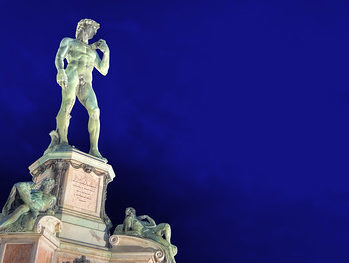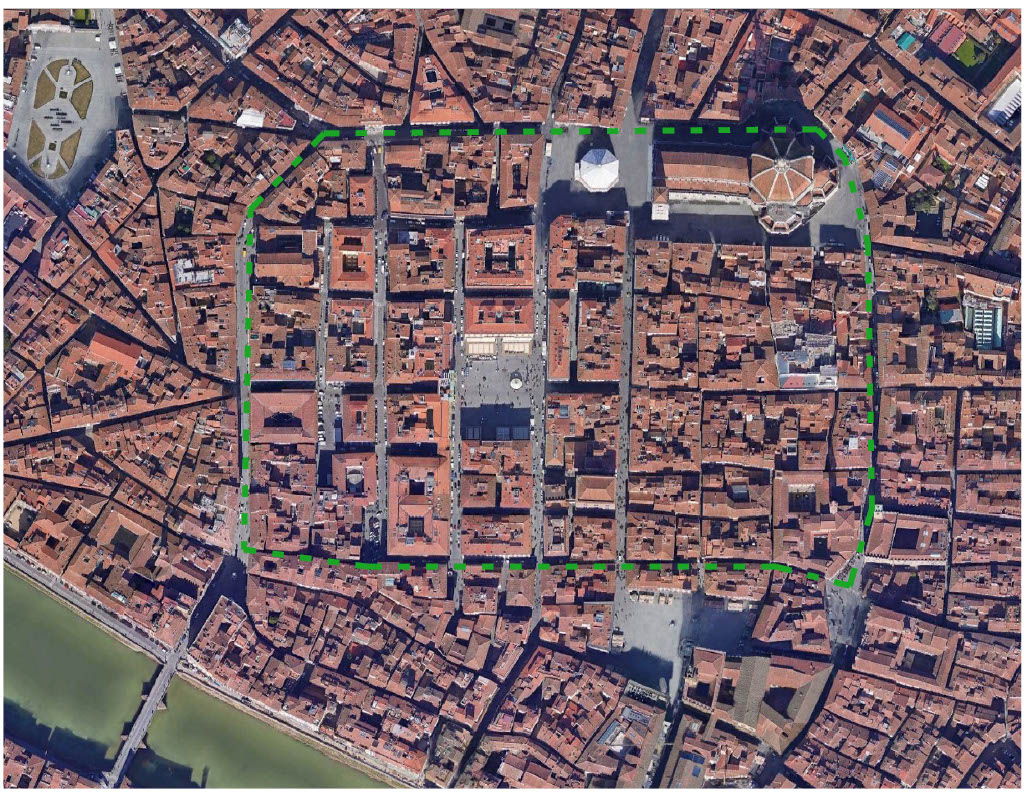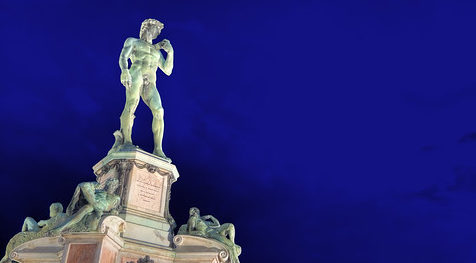Architecture of Florence, Tuscany, Italy
Florence is one of the most influential cities in European History and was the birthplace of the Italian Renaissance. The city contains countless works of architecture spanning multiple ages. Of course, there are the main Renaissance attractions like Florence Cathedral, but there are also monuments from Florence’s medieval past, as well as buildings from after the unification of Italy. Today, Florence has grown into a sprawling city, but its historic center remains one of the best-preserved in Europe. Millions of tourists visit the city every year to see the architecture, paintings, and sculptures from when Florence was at the epicenter of the Renaissance Movement that swept across Europe.

Map of Florence
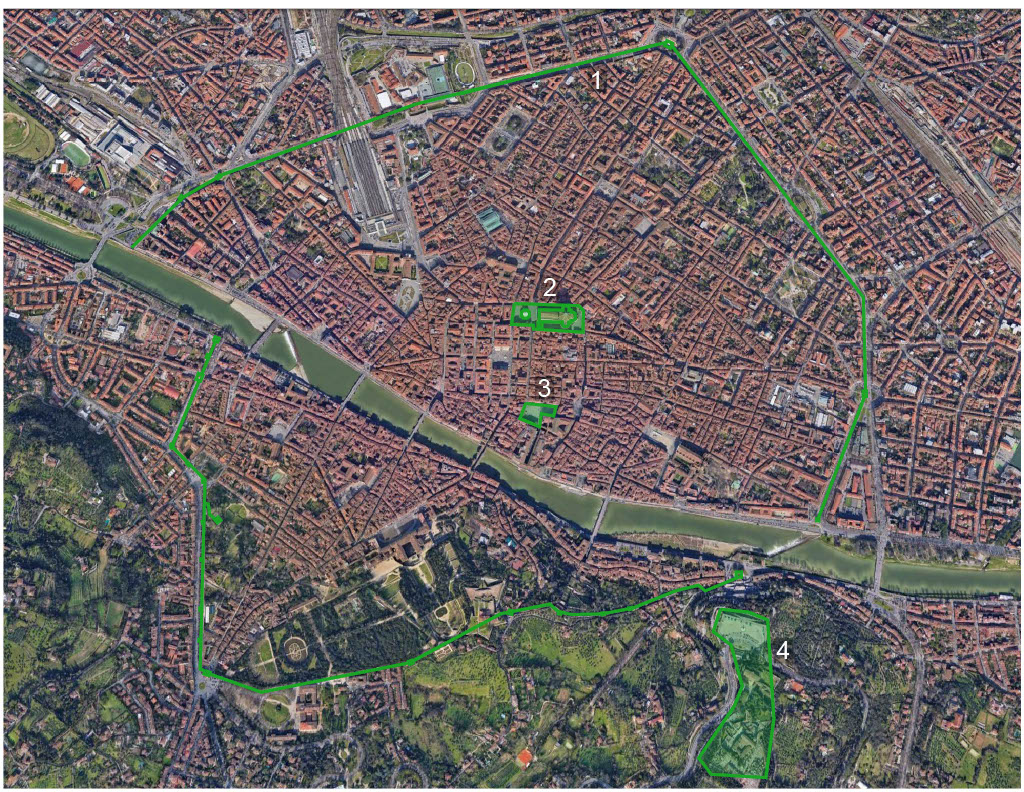
Map of Florence highlighting some of the city’s main attractions.
1. Outline of the historic center of Florence – the line shows the path of the defensive wall of Florence, of which only about 30% remains
2. Piazza del Duomo & Florence Cathedral – Florence’s Cathedral is regarded as one of the most impressive in all of Europe
3. Piazza della Signoria & Palazzo Vecchio – the main cultural and political square throughout Florentine history
4. Church of San Miniato al Monte & Piazzale Michelangelo – Florence’s most popular lookout point
Table of Contents
History of Florence
Unifying Elements in Florentine Architecture
Multi-Colored Marble
Photo by Holly Hayes from flickr

Marble is one of the unifying materials found in nearly all the historic architecture of Florence. The most famous example is, of course, the exterior marble found at Florence Cathedral. White, green, and red marble from different parts of Italy were all utilized to decorate the outside of the church. The use of multiple colors of marble was common even in the earliest buildings found in Florence. The Church of San Miniato al Monte (depicted above) and the Baptistry of Florence Cathedral are two Romanesque Buildings that contain similar multi-colored marble stonework.
Frescoes
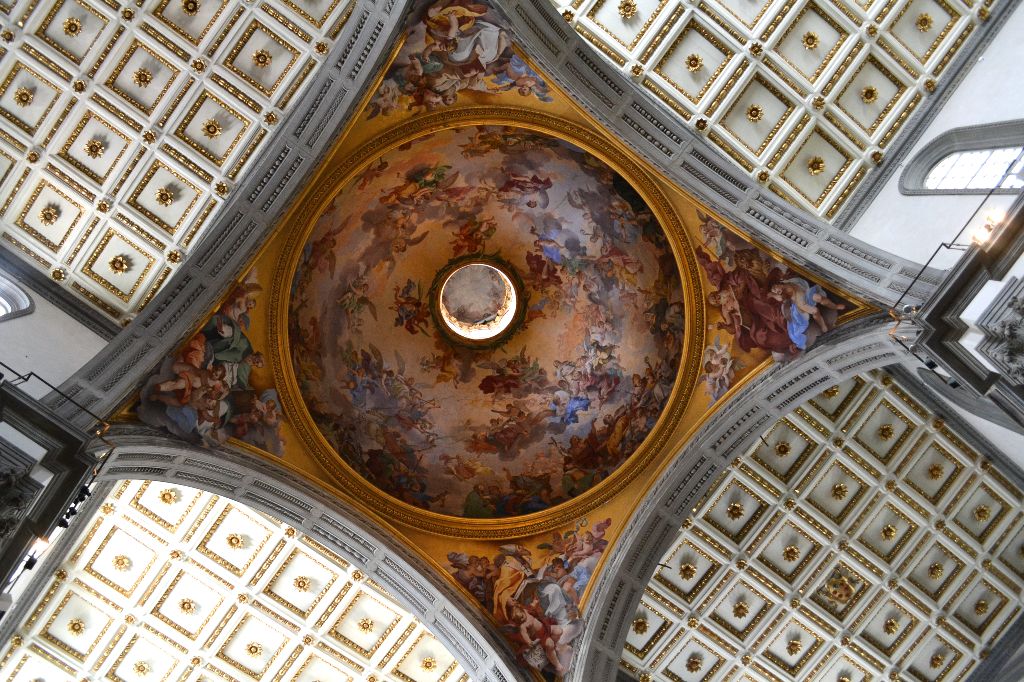
Frescoes are an integral part of the architecture of Florence. The earliest examples of Florentine frescoes can be found at the apse of the Basilica di Santa Croce. The frescoes of Santa Croce were pre-Renaissance and are some of the most iconic works of Gothic Art in Florence. The dome of the Basilica di San Lorenzo (depicted above) contains a much later fresco called the Glory of Florentine Saints, which dates from the late 1700s.
Blue/Grey & White Color Scheme
Photo by Miguel Hermoso Cuesta from Wikimedia commons

Florence also has a large number of buildings that all contain the same exact color scheme. This combination of a pale blue/grey color paired with white can be found throughout the city. Filippo Brunelleschi was one of the first architects to use these colors when de designed the Pazzi Chapel in 1421. A few other examples of this are the interiors of Florence Cathedral, the Basilica di San Lorenzo, the Basilica di Santo Spirito, and Michelangelo’s New Sacristy. Similar color combinations can also be found in the marble stonework at the Church of San Miniato al Monte and the Baptistry of Florence Cathedral.
Renaissance Style Facades
Photo by CEphoto, Uwe Aranas from Wikimedia Commons

Many different Renaissance-style facades can be found on the exteriors of the buildings in Florence. Although many of these facades don’t date from the actual period of the Italian Renaissance, they still borrow many of the style’s distinct features. This cluster of buildings is located along the eastern side of Piazza Santa Maria Novella. Although each building dates from a different year, they all show the same symmetry and repetition commonly found in all Renaissance Architecture.
Medieval Architecture in Florence
The Republic of Florence was established in 1115, and a new constitution was established in 1293. From then on, the city was ruled by the wealthy mercantile class, and there were several noble families that all competed with one another for power and status. Florence also had many guilds representing wool traders, silk merchants, bankers, and other trades, which also played a part in the city’s government. It was during this time that famous artists started emerging in the city like Dante Alighieri, who was born in 1265. Today in Florence, you can find several examples of Romanesque Architecture from the early phases of the Florentine Republic, as well as works of architecture from the Gothic Age.

Map of Florence highlighting the most notable works of Gothic and Romanesque Architecture within the city.
The dashed line represents the original medieval wall, and the new wall built in the 14th century is shown with a solid line.
1. San Miniato al Monte

Perched high on a hilltop overlooking the historic center of Florence is San Miniato al Monte. The church dates from the Romanesque age, and construction began in 1013. Some of the final touches weren’t completed for centuries, such as the mosaics at the Apse, which were completed in 1297. The front facade and most of the interior feature the same blue & white colored scheme. Two different types of marble are arranged in geometric patterns.
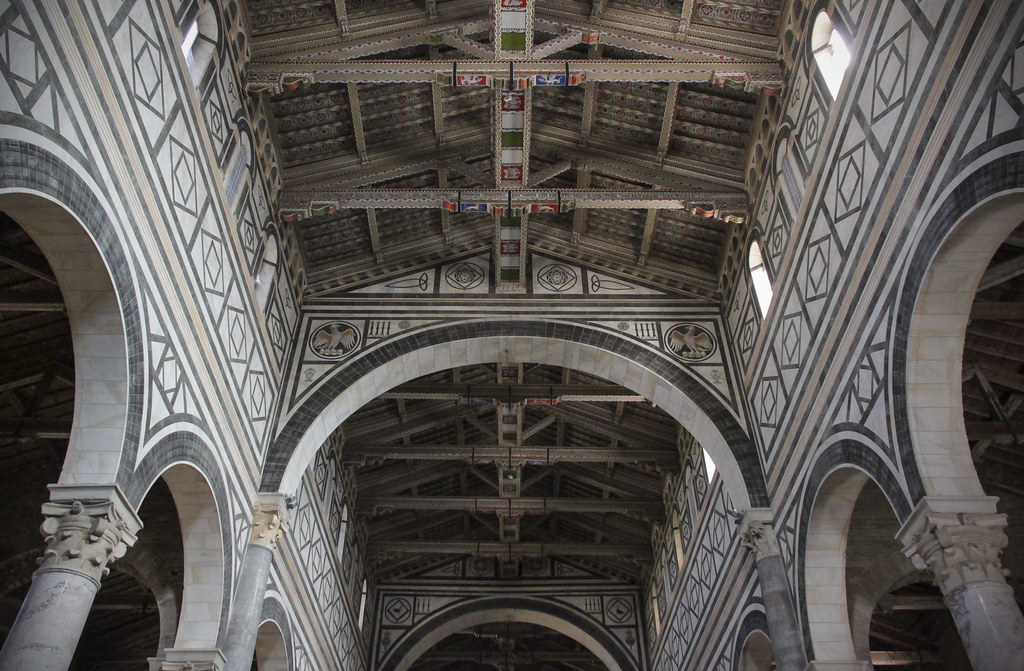
San Miniato al Monte is a Basilica Style church with three aisles. The central Nave is capped with a wooden roof structure that is one of the best-preserved of any Romanesque Church in Europe. Colorfully painted designs decorate the timbers, and they show how skillful the craftsmen were in Florence, long before the Renaissance that came centuries later. Even though there are several larger churches in the middle of the city, San Miniato al Monte is still one of Florence’s finest buildings.
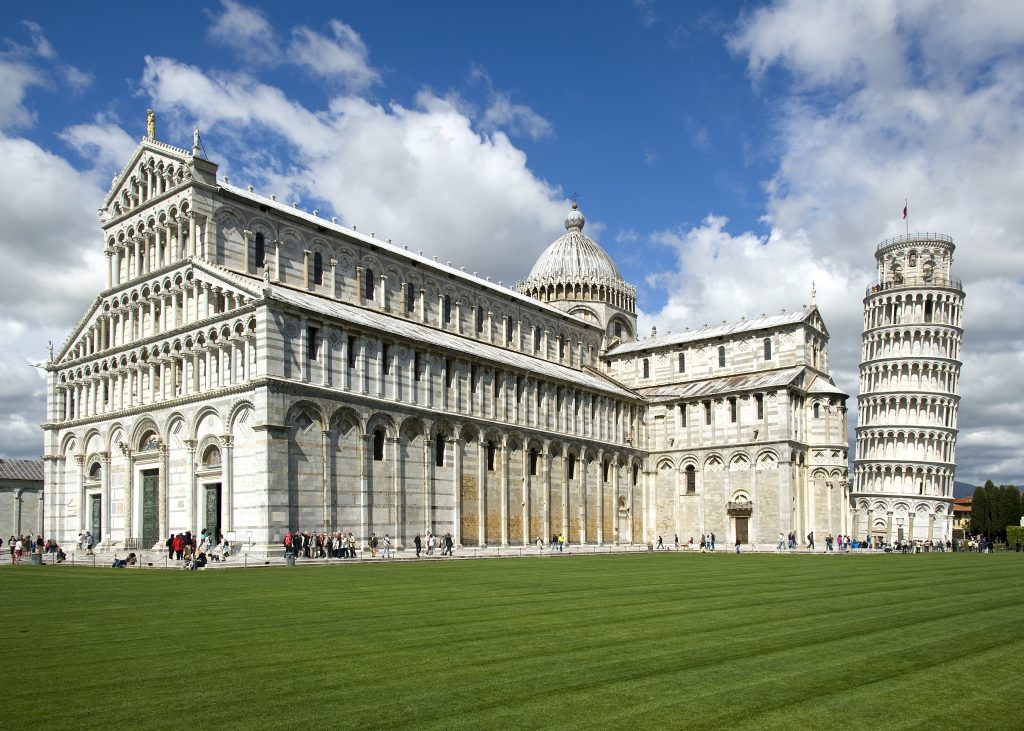
Romanesque was Europe’s dominant architectural style from the 10th-11th century. Read our article, “Romanesque Architecture and the Top 15 Romanesque Buildings” to learn more!
2. Palazzo Vecchio

In 1299, city officials decided to build a new and impressive palace to house the local government. Over the following centuries, work continued as the Palazzo Vecchio was built and expanded. The exterior of the building is made entirely of bricks and features many elements of Gothic Architecture. The front facade looks over the Piazza della Signoria, one of Florence’s oldest public piazzas. The interior of the buildings is richly decorated with artwork, and the incredible Grand Hall is where the Medici Rulers of Florence would conduct a lot of their important business.
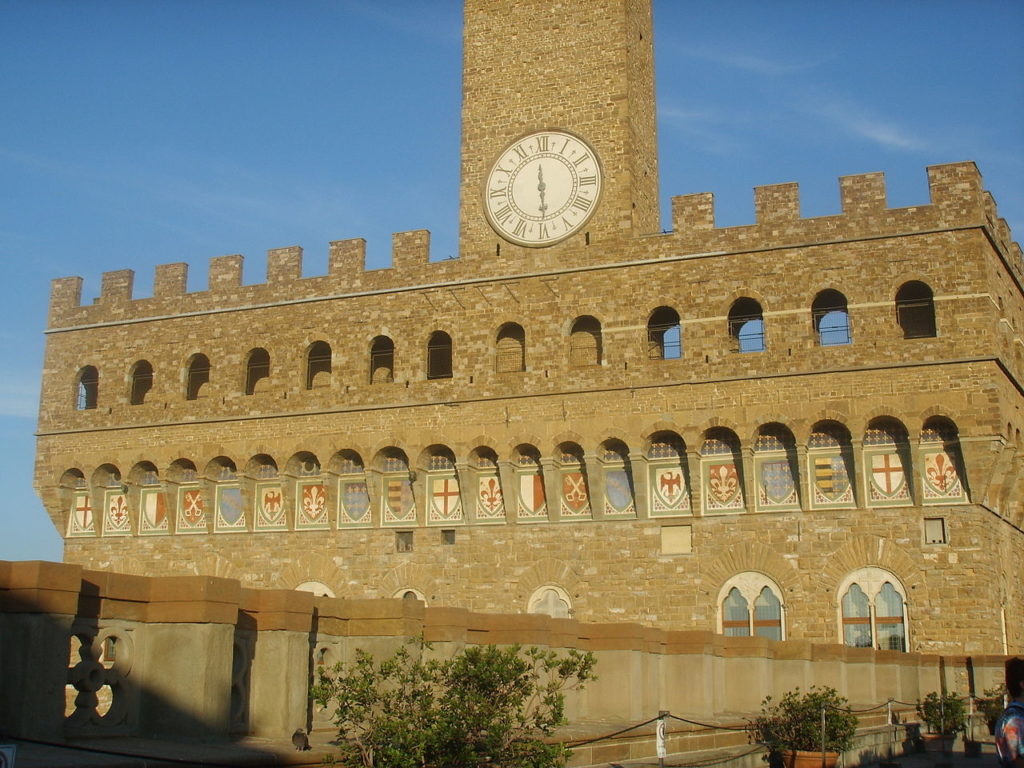
The facade is also decorated with the crests of other Italian nations, such as Genoa, Naples, and the Papal States. The tower was built around 1310 and it was once the highest point in the entire city at 308 feet (94 m) high. It was also one of the tallest structures in all of Tuscany, but the nearby city of Siena completed a tower that was slightly taller in 1348. The tower of Palazzo Vecchio is also famous for its one-handed clock, which tells time to a degree of accuracy that was just fine for the people back then.
3. Baptistry of Florence Cathedral
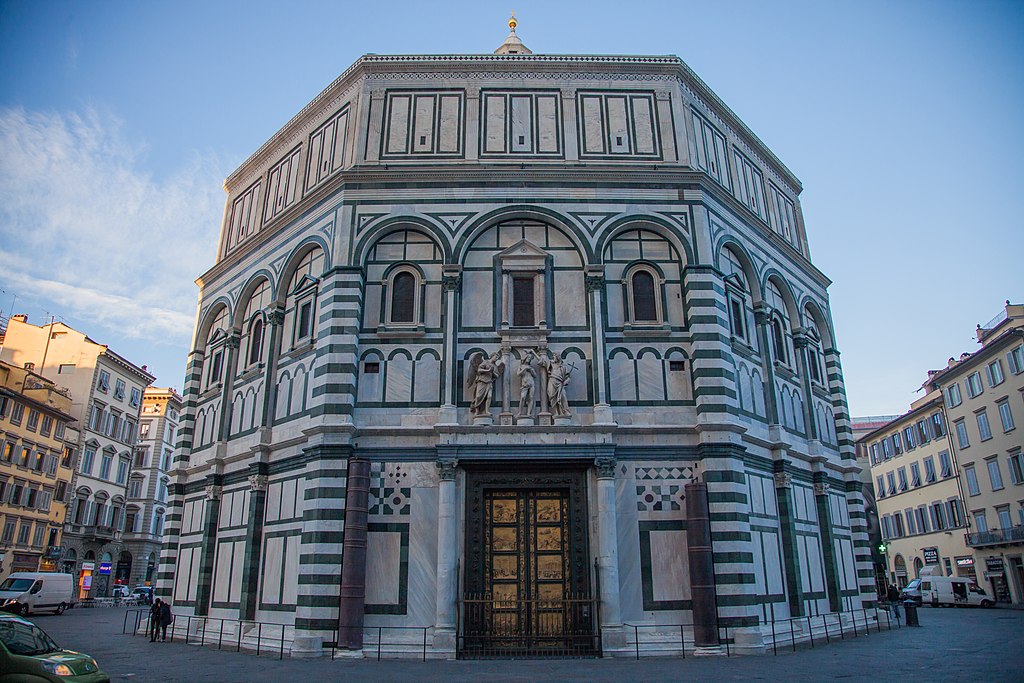
Florence Cathedral, like a lot of other churches in Italy, has a baptistry that is a separate building located right next to the main church. This separation was because of the belief that no one could enter the main church until after they were baptized. Construction on the Baptistry of Saint John began in the year 1059 and it wasn’t completed until later in the 12th century. You can see many typical elements of Florentine Architecture throughout the building, such as the use of blue and white marble, just like at San Miniato al Monte, which was built in tandem with the baptistry.
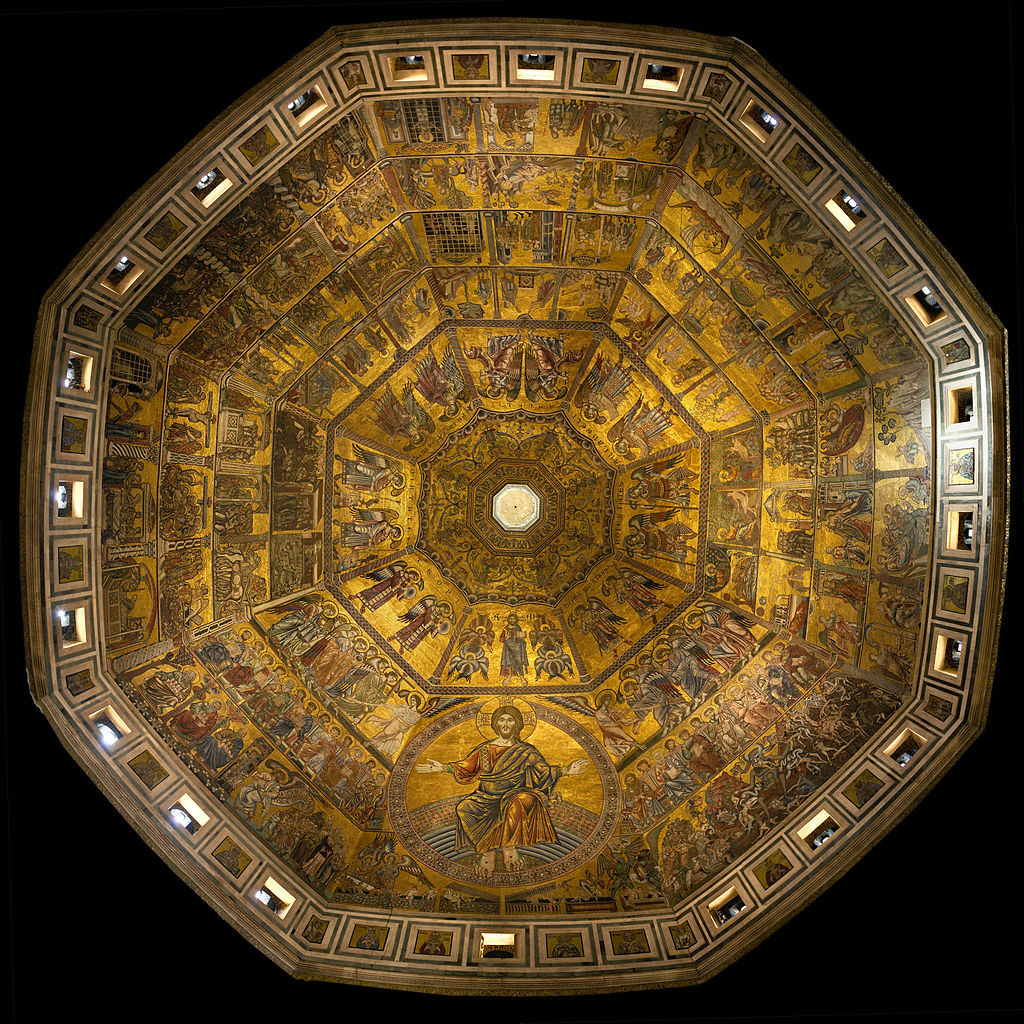
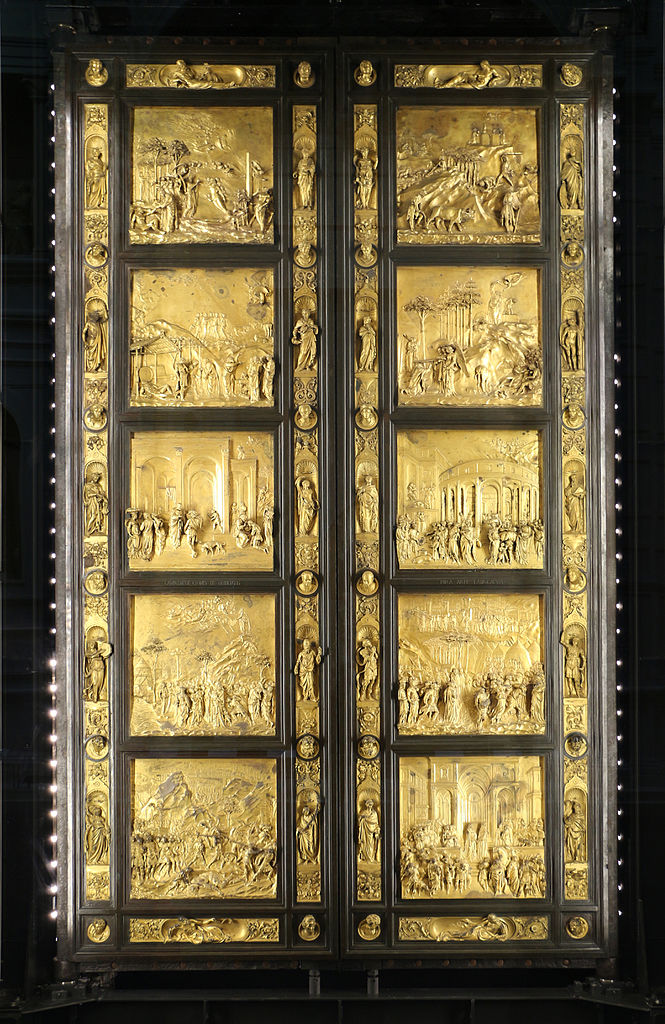
(right) Photo by Sailko from Wikimedia Commons
The baptistry features a lot of famous works of art from both the Florentine Renaissance and the early Medieval Period. The dome is covered by an incredibly complex Byzantine Style Mosaic, which dates from the 13th century. This was a time when the Republic of Venice and the Byzantine Empire both had a strong influence on the architecture of Italy. But the baptistry’s most infamous works of art are the bronze-cast doors designed by Lorenzo Ghiberti. The Gate of Paradise (right image above) was built with 10 panels, each depicting a scene from the Bible. Ghiberti used new techniques like perspective in a way that amazed the people of Florence at the time. Ghiberti’s work influenced the art and architecture of Florence for centuries, and many regard the completion of his Gate of Paradise as the start of the Italian Renaissance.
4. Basilica of Santa Croce

In the year 1294, construction began on the Basilica of Santa Croce. It is one of several Gothic Style churches in Florence. It took about 200 years to build the church, and it wasn’t until the 19th century that the Gothic Revival Facade was added to the main elevation. Santa Croce has a total of 16 different chapels, many of which contain artwork from every period of the Renaissance Movement, including masterpieces by Giotto and Donatello.

Santa Croce is also renowned as the final resting place of many famous Italians, including Galileo, Machiavelli, and Michelangelo. Countless works of Renaissance and Baroque sculpture decorate the graves of these important people from Florence’s past. The Nave of Santa Croce displays many of the key elements of the Gothic Style, including pointed arches and stained glass windows. Although some of the art dates to the Renaissance and the period that followed, most of the actual architecture of the church dates from the early Medieval Period during the Republic of Florence.
5. Ponte Vecchio

The Ponte Vecchio is the oldest bridge that still stands in the city of Florence. Historians believe that it replaced an older bridge that was built during Roman times. As was common in the Middle Ages, this bridge is topped with buildings and structures that are occupied by merchants. Although the tenants have changed over time, today, the shops are occupied primarily by jewelers. During the final stages of WWII, as the Nazi’s were fleeing Florence, every single bridge in the city was destroyed, except for the Ponte Vecchio. Because of this, the Ponte Vecchio is one of the best-preserved medieval bridges in all of Europe.
6. Giotto’s Campanile

Florence Cathedral was built with a detached baptistry and a separate bell tower. The bell tower is now nicknamed Giotto’s Campanile since it was designed by Giotto di Bondone in 1334. Giotto would only see the start of his tower take shape. He died in 1337 but work still continued, and the campanile was completed in 1359. The bell tower follows the same green, white, and red color scheme as the rest of Florence Cathedral. Coordinating the three different colors must have been a huge challenge, especially when considering that each shade of marble came from a different part of Italy.
7. Piazza della Signoria & Loggia dei Lanzi
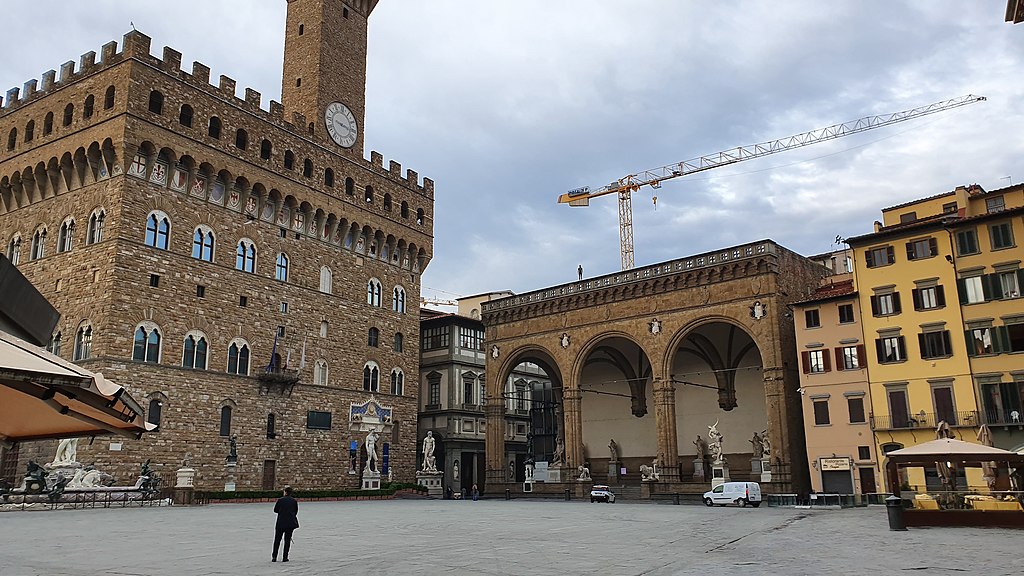
Piazza della Signoria is an open space that serves as Florence’s main cultural and political center. The Palazzo Vecchio is positioned at the southeast corner of the square, right next to the main avenue of the Uffizi Gallery. The Loggia dei Lanzi also occupies a large part of the square. The loggia was built over 6 years, starting in 1376. Many famous events in Florence’s history took place right here in this square, such as the unveiling of Michelangelo’s David, and the execution of Girolamo Savonarola.
8. Tower San Niccoló, Porta Romana, and the Medieval Walls of Florence

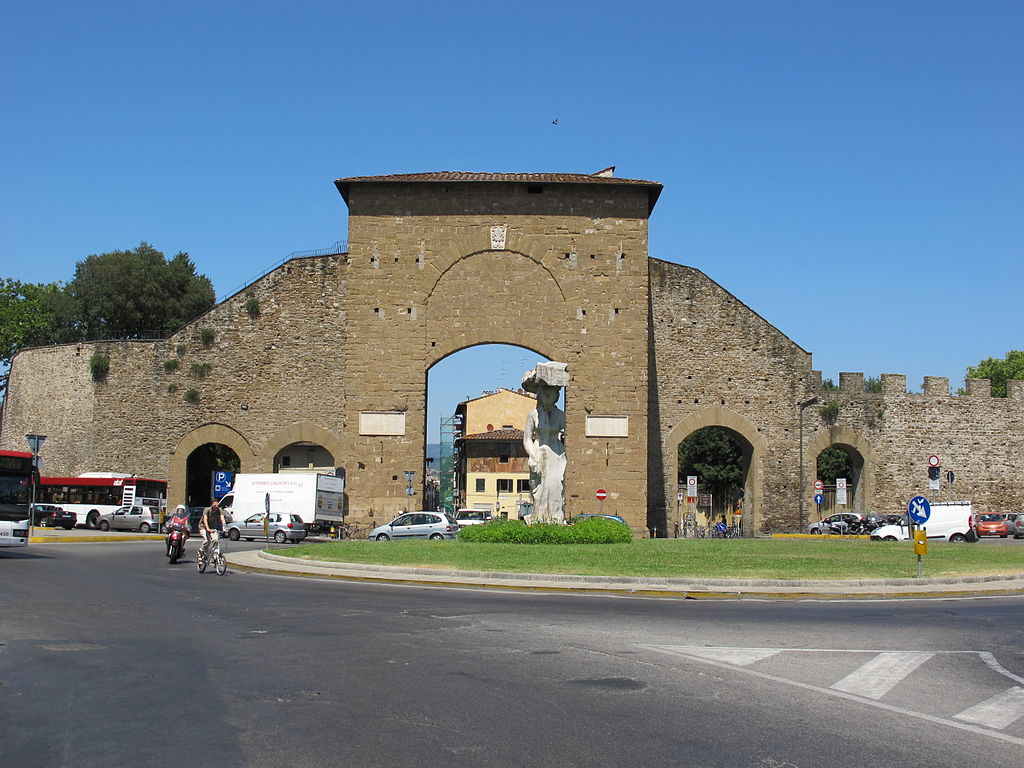
(left & right) Photos by Sailko from Wikimedia Commons
Florence once boasted one of the strongest walls of any Italian city. Most of the walls date to the 14th century, but they were heavily reinforced over time. Later in the 19th century, along with countless other cities in Europe, Florence decided to demolish large portions of its defensive walls. This was a way to open up the city, and make way for modern roadways. Today, several remnants of the medieval defenses are still intact, such as the Porta al Prato, the Porta San Gallo, the Porta Romana, and the Tower of San Niccolò.
9. Orsanmichele
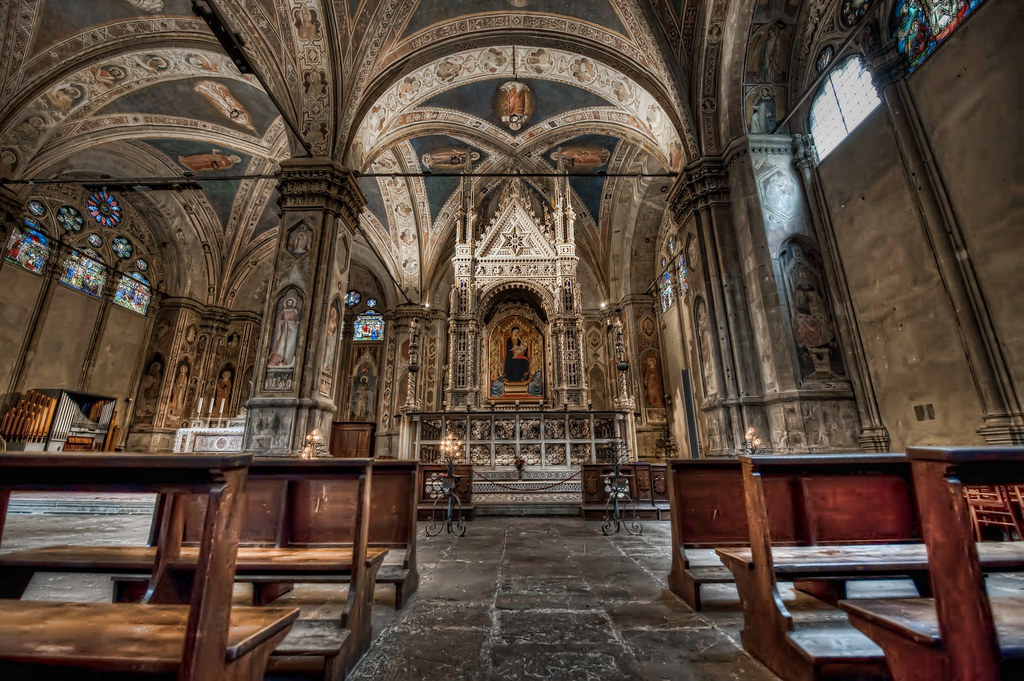
The Orsanmichele was originally built as a market hall in the middle of the 14th century, but it was later converted into a church dedicated to Saint Michael. The interior of the church is known for its elaborate frescoes from the medieval era. The exterior of the church is also lined with 14 different niches, each containing statues commissioned by the important industrial guilds of the city. There’s a depiction of St. Mark by Donatello, a statue of St. Peter by Brunelleschi, and three different figures carved by Lorenzo Ghiberti.

Gothic Architecture was the dominant building style in Italy from the 13th-14th century. Read our article, “Gothic Architecture: The Top 25 Examples” to learn more!
10. Bargello National Museum

The Bargello National Museum, also known as Palazzo del Bargello, is a Gothic Style palace built by a Florentine Noble Family in the 13th century. The building features many distinct elements found in the Gothic Architecture of Florence, including the crenelations at the roofline. Today, the palace houses a large art collection, with notable works by artists such as Cellini and Bernini.
Renaissance Architecture in Florence
The architecture of Florence is dominated by one particular art movement, the Renaissance. Many modern scholars call Florence the “birthplace” or the “cradle” of the Renaissance, and that’s because many of the earliest examples of this style were built by Florentine Artists starting in the 15th century. Early Renaissance artists like Lorenzo Ghiberti (1378-1455), Donatello (1386-1466), and Filippo Brunelleschi (1377-1446), were all starting to emerge at this time.
Eventually, in the 1500s the Renaissance reached its peak. Legendary artists such as Michelangelo (1475-1564), Leonardo da Vinci (1452-1519), and Raphael (1483-1520) began getting commissions from Florence’s wealthy patrons. At this time the wealthy banking family known as the Medici began to solidify their place as the rulers of the Republic of Florence. Cosimo de’ Medici and his grandson Lorenzo essentially acted as the head of the Florentine government during this time period. Lorenzo would go on to be known as Lorenzo the Magnificent, and he was one of the Medici’s most powerful leaders.

Map of Florence highlighting the most notable works of Renaissance Architecture within the city.
1. Florence Cathedral

Florence Cathedral, also known as the Cathedral of Santa Maria del Fiore, or Duomo di Firenze, is by far the most incredible building in all of Florence. It was hard to decide where to put Florence Cathedral in this article since it originally dates from 1296. Many elements from Gothic Architecture can be found throughout the building. However, the interior of the church wasn’t enclosed until the 15th century, when the infamous dome designed by Filippo Brunelleschi was completed. Even after that, the facade of the church wasn’t finished until 1887.
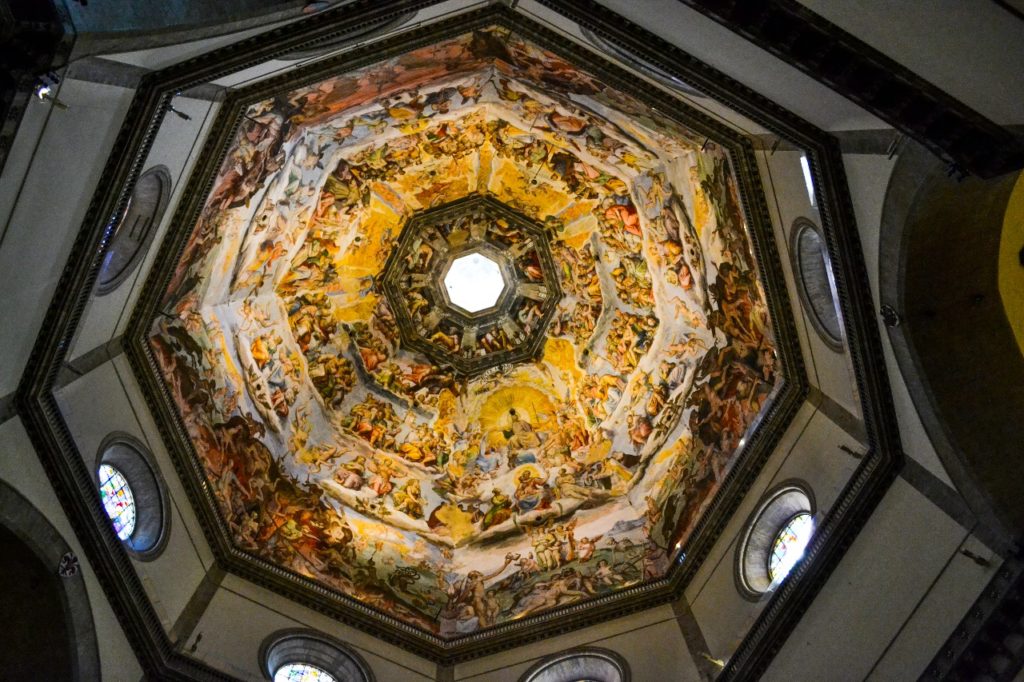
The dome of Florence Cathedral was an engineering marvel of the Renaissance. The original design of the church called for the construction of the World’s Largest Dome at that time, larger than that of the Pantheon in Rome. The only problem was – no one was really sure how to build such a massive structure. The city held a design competition in 1418, which Filippo Brunelleschi won, thanks to his innovative dome-within-a-dome design. Florence Cathedral actually contains an outer dome and a separate inner dome, each supporting the other to spread the load of the structure. The dome of Florence Cathedral is the highest point in the city’s historic center. You can see the incredible view from the top of the dome in this Photo Sphere.

Today, Florence Cathedral is still completely surrounded by a large open space, known as the Piazza del Duomo. Its one of the city’s most lively public spaces, and millions of people visit the entire cathedral complex every year, including the baptistry, bell tower, and the main church. The cathedral is so important and influential, that was one of the first buildings to be inscribed as a UNESCO World Heritage Site in 1982, along with the rest of the historic center of Florence.
2. Uffizi Gallery
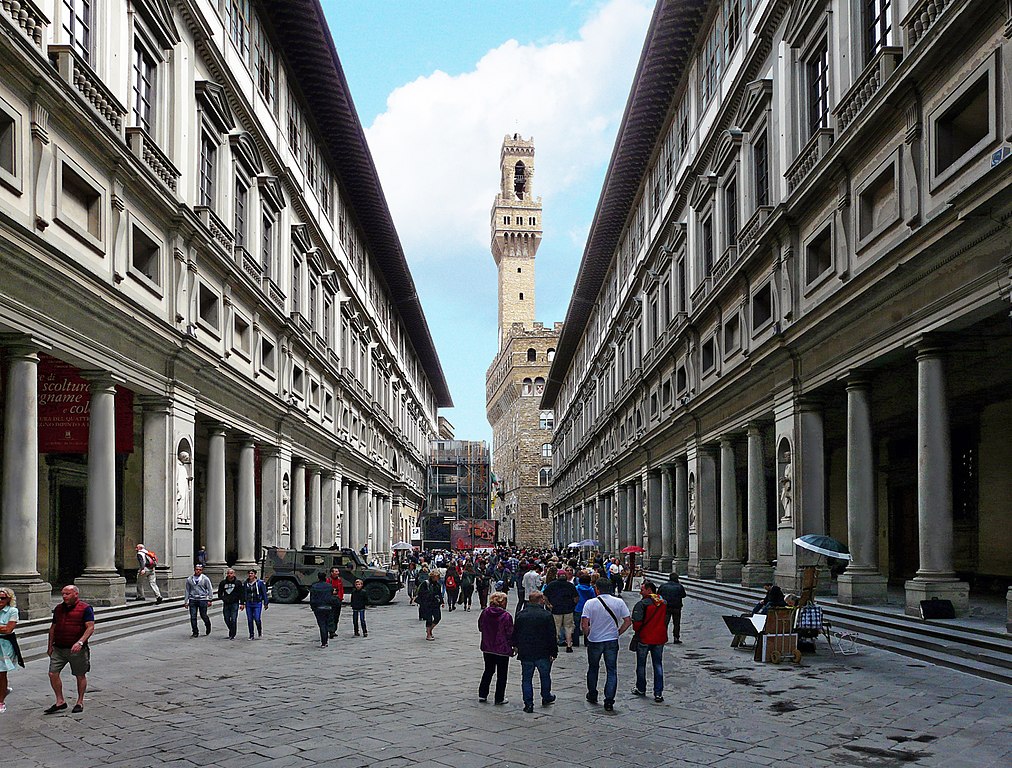
The Uffizi Gallery is the second most visited museum on the Italian Peninsula, after the Vatican Museums in Rome. The original building was started in 1560, and it was commissioned by Cosimo I de’ Medici. The main courtyard within the museum directly connects the Piazza della Signoria with the banks of the Arno River. The two opposing facades of the courtyard feature some of the key elements of Renaissance Architecture, such as Doric columns, statues and niches, and a symmetrical design.
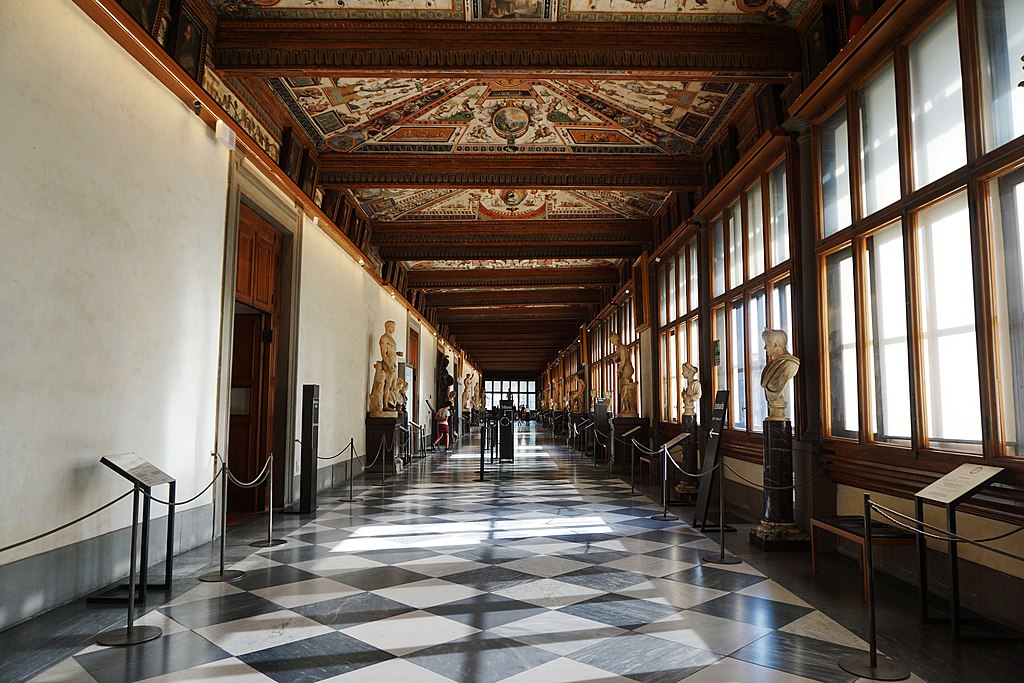
The museum has a massive collection of paintings and sculptures from many different periods. Some very early paintings by Giotto are located in one of the galleries, as well as works from Renaissance masters Raphael and Michelangelo. The Birth of Venus is possibly the museum’s most famous work, a masterpiece by Sandro Botticelli that was completed in 1485. The Uffizi Gallery also contains art from the period that followed the Renaissance, the Baroque Age. Caravaggio was one of the Baroque period’s greatest artists, and you can find several of his paintings at the Uffizi.
3. Basilica di San Lorenzo
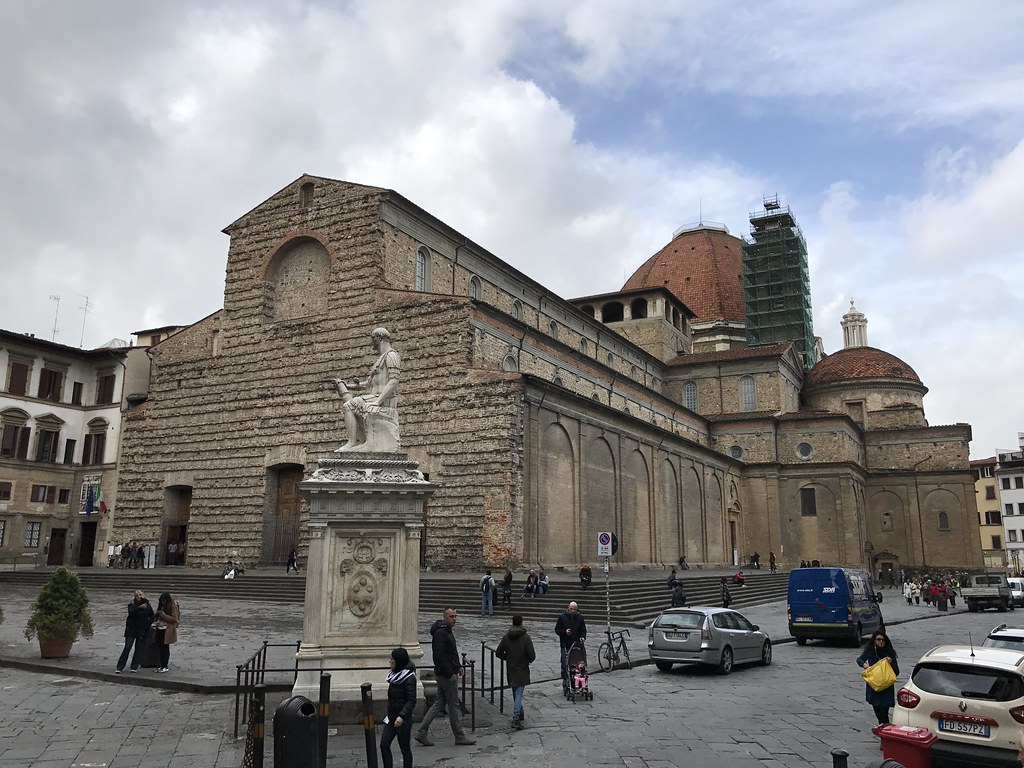
The first thing most people see when they look at the outside of the Basilica di San Lorenzo is the barren front facade. Unlike several other churches in Florence, such as Santa Croce, San Lorenzo’s front elevation was never covered up by a veneer of fine Italian Marble. But the church does contain one of the most harmonious Renaissance interiors found anywhere in Florence.
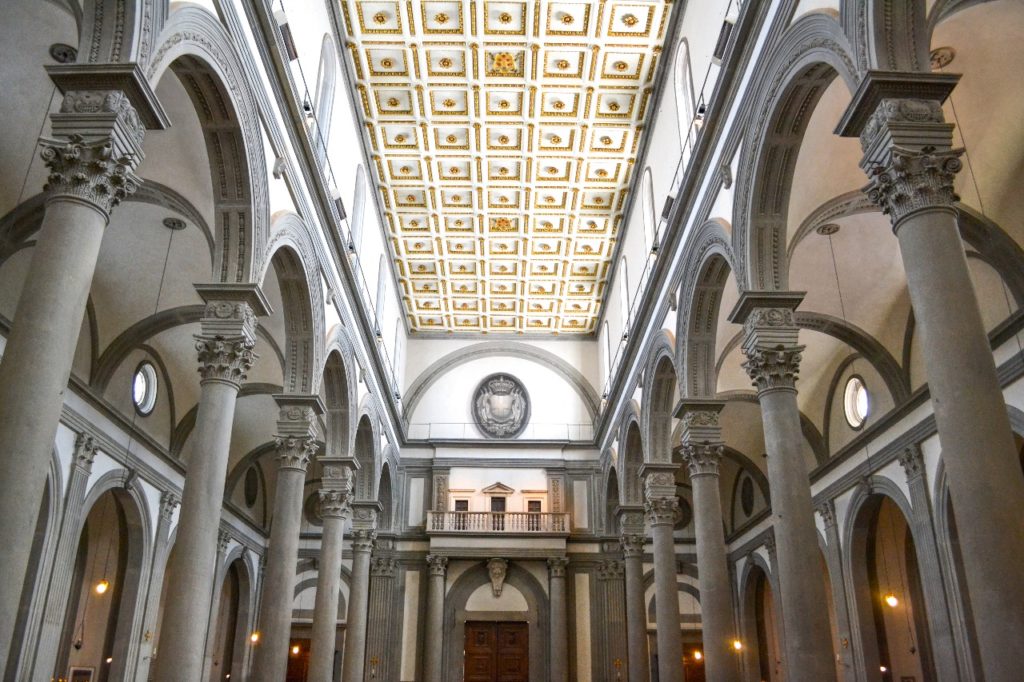
Work started on the church in 1419 and was mostly completed by 1459. The interior contains just about every element of Renaissance Architecture you can think of. There are Corinthian columns, coffered ceilings, and pediments above some of the windows, which are all borrowed elements from classical Roman and Greek Architecture. San Lorenzo also embodies some of the more complex building features of the Renaissance Style, such as symmetry and rigid proportions that dictate the sizes of different spaces.
4. Laurentian Library

Built in a cloister located right next to the Basilica di San Lorenzo is the Laurentian Library. The building was commissioned by Giulio de’ Medici, a wealthy member of the Medici Family. Giulio became the second Medici Bishop of Rome when he was elected Pope in 1523. Construction began on the library just two years after this. Michelangelo designed the reading room and the vestibule. The reading room (above) contains two rows of desks, each perfectly aligned with one of the windows. Check out this Photo Sphere to get a better understanding of the space.
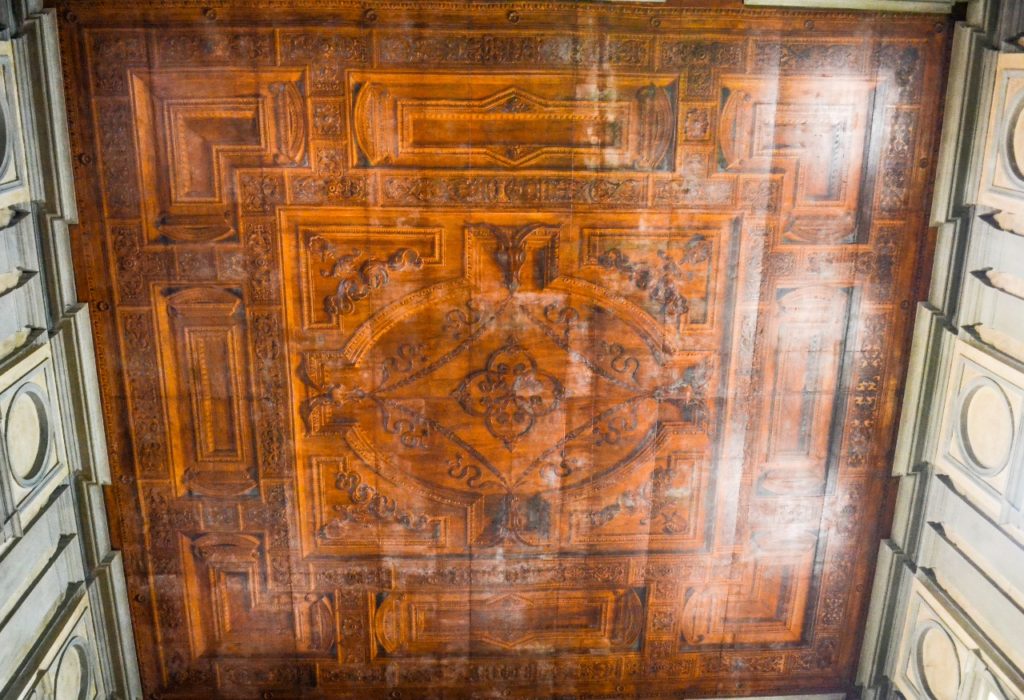
The vestibule is a perfectly square room, measuring about 34 feet (10.5 m) by 34 feet. It contains a monumental staircase connecting the reading room with the main floor of the building. The architecture of the vestibule matches the reading room and contains many of the key elements of Florentine Renaissance Architecture. Today, the Laurentian Library is home to over 15,000 books and manuscripts containing important literature from Florence’s historic past.
5. Basilica of Santa Maria Novella (façade)
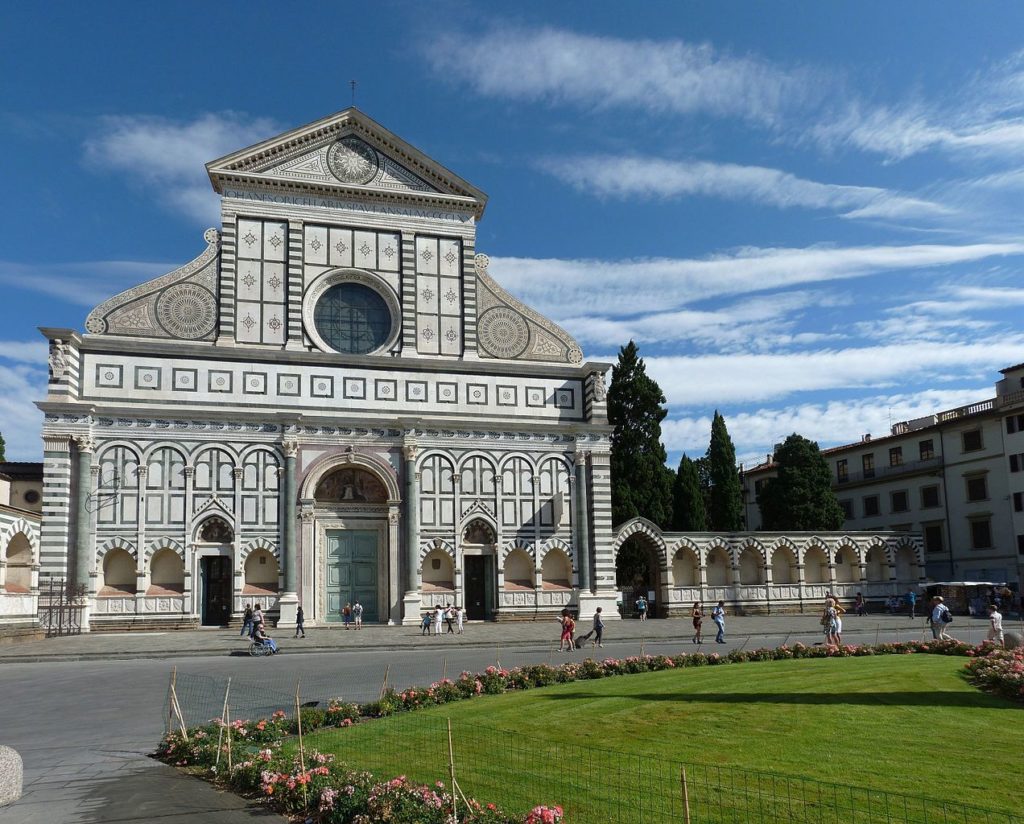
The Basilica of Santa Maria Novella has a Renaissance facade that was designed by Leon Battista Alberti. Before Alberti’s facade was completed in 1470, the front of the church looked very similar to the front of the Basilica di San Lorenzo. However, the exterior marble was added to create one of the most iconic examples of Renaissance Architecture in Florence. The green and white marble was imported from different parts of Italy, and the church was designed with the same color scheme as Florence Cathedral.
6. Hall of the Five Hundred at Palazzo Vecchio
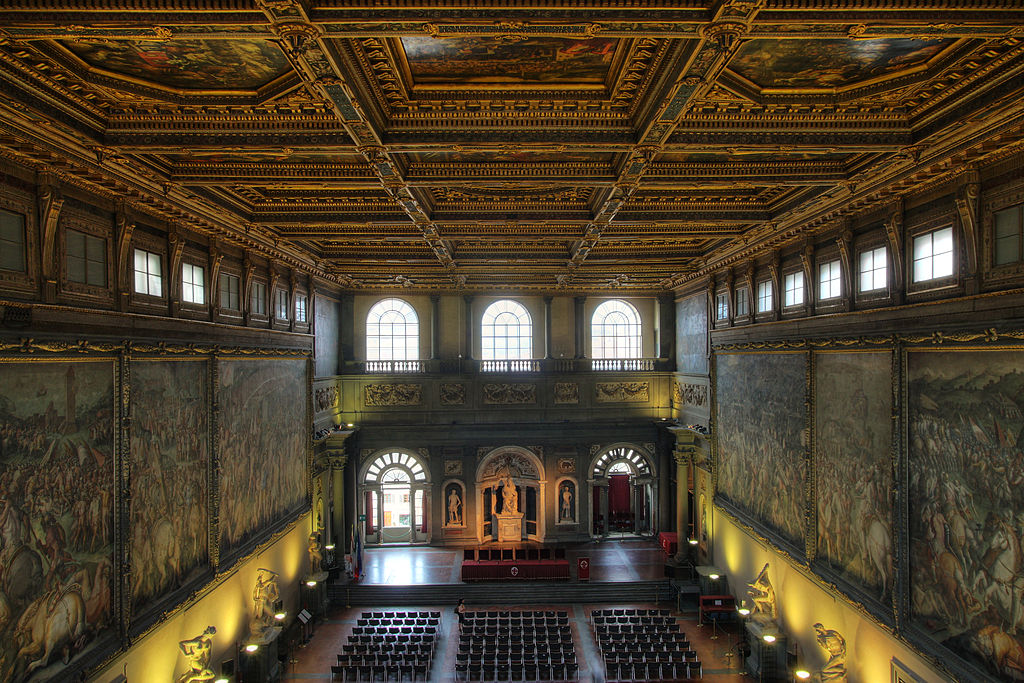
After ruling Florence since the mid-1400s, the Medici Family basically moved into the Palazzo Vecchio in 1540. Before this, they had been conducting all of their business from the Palazzo Medici. But Cosimo I de’ Medici made the bold choice to move his affairs into Florence’s main government building. The Hall of the Five Hundred, known in Italian as Salone dei Cinquecento, was completely remodeled during this time. The walls feature massive paintings depicting Florence’s various military victories over their neighbors Pisa and Milan.
7. Palazzo Pitti
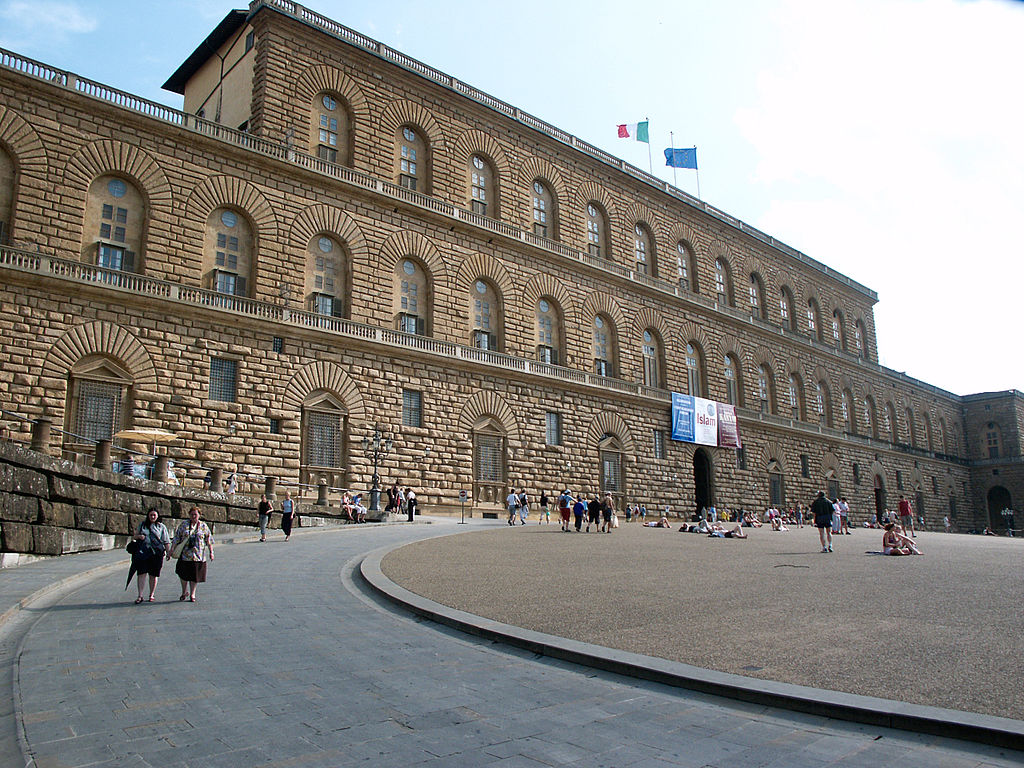
Palazzo Pitti was built by Luca Pitti, a Government official who served alongside the Medici. He commissioned the building in 1458 and it was designed with an impressive Renaissance Facade. The Palazzo is situated on one of the main roads leading into Florence, where the Ponte Vecchio crosses the Arno River. Palazzo Pitti was later purchased by the Medici family and it served as their primary residence. The Medici family greatly expanded the original building and updated the interiors. The palace even served as the Royal Residence of the Italian King after Florence became the capital of the newly united Italy in 1865.
8. Ospedale degli Innocenti
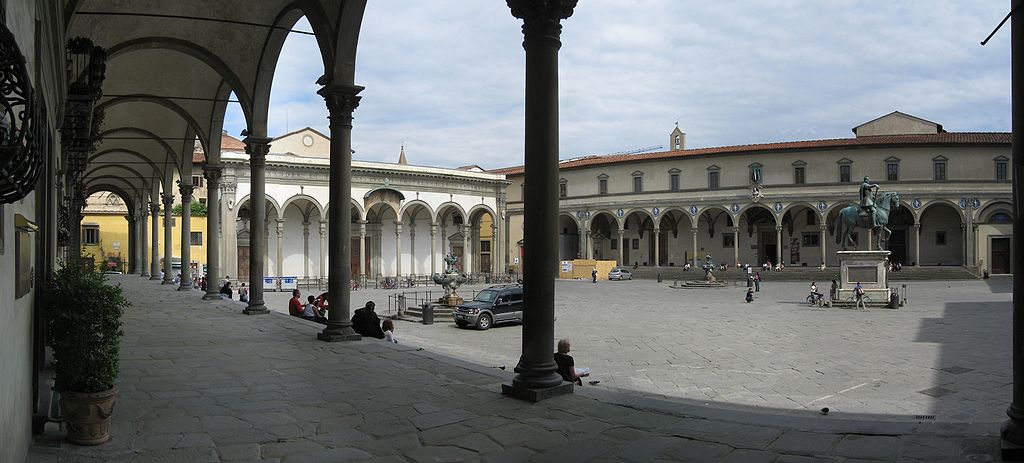
The original loggia at the Ospedale degli Innocenti was designed Filippo Brunelleschi in 1419. It’s one of the best examples of Renaissance Architecture from the time period. The design was so popular with the people of Florence that several architects imitated it in later buildings. The Ospedale degli Innocenti, the Basilica della Santissima Annunziata, and the Loggia dei Servi di Maria were all built at different times but follow the same Renaissance principles as Brunelleschi’s original composition.
9. Pazzi Chapel

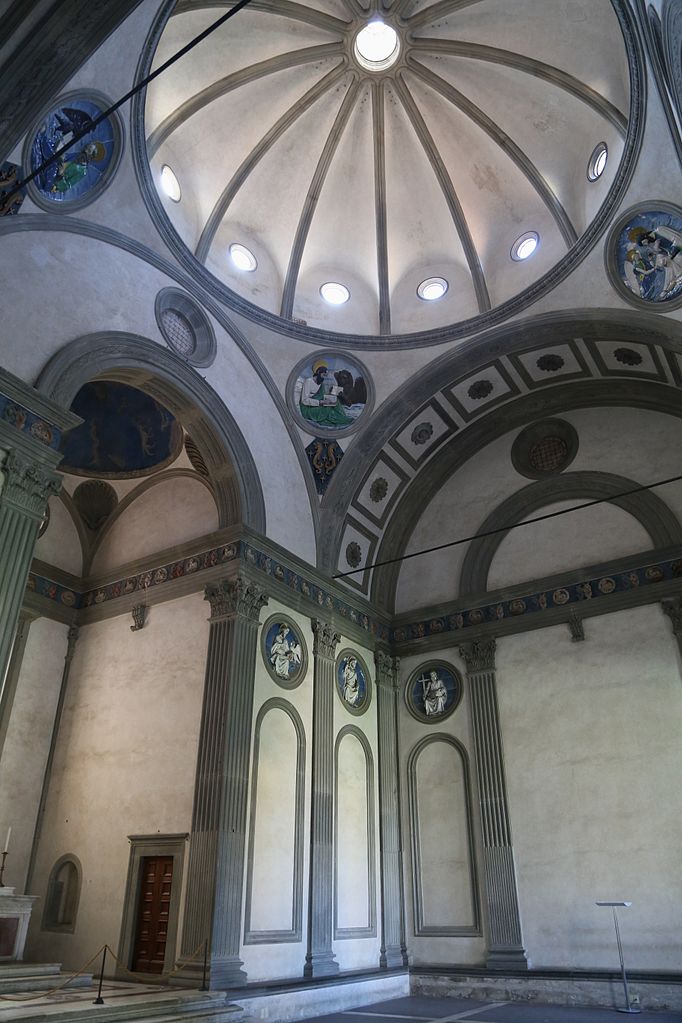
(right) Photo by Rufus46 from Wikimedia Commons
The Pazzi Chapel is actually located within the cloister of the Basilica of Santa Croce, a church from the “Medieval Architecture of Florence” section. Just like the Ospedale degli Innocenti, it was designed by Filippo Brunelleschi, who was one of the most productive architects of the Renaissance. The chapel was completed in 1443, and it was one of the most well-known buildings of Brunelleschi’s career. Although the Pazzi Chapel is just a small portion of a larger church, it’s still a hidden gem of Renaissance Architecture in Florence that can easily go unnoticed tucked away in the basilica’s cloister.
10. Michelangelo’s New Sacristy

The Sagrestia Nuova or New Sacristy is a renaissance-style chamber that was added to the Basilica di San Lorenzo. Michelangelo designed the space, and not only is it one of his greatest works of architecture, but it also contains four of his most noteworthy sculptures. The four sculptures decorate the lids of Medici Tombs. Each of the four shows a different person representing night, day, dawn, and dusk. The image above shows the incredible coffered ceiling decorating the pendentive dome. The interior of the dome is meant to look just like the interior of the dome of the Pantheon in Rome. To get a complete view of the space and see all of Michelangelo’s sculptures, check out this Photo Sphere.
11. Vasari Corridor

The Vasari Corridor is a massive covered arcade that connects several of Florence’s main attractions. The path starts across the Arno River by the Palazzo Pitti, it then crosses the river as part of the Ponte Vecchio. From there it connects the bridge with the Uffizi Gallery (depicted above), and then the Uffizi Gallery Arcade acts as a final extension all the way to Palazzo Vecchio. During the Renaissance, the Medici and other wealthy Florentines used this convenient pathway on a daily basis. Today tourists and locals alike also take advantage of the Vasari Corridor to keep out of inclement weather.
12. Basilica di Santo Spirito
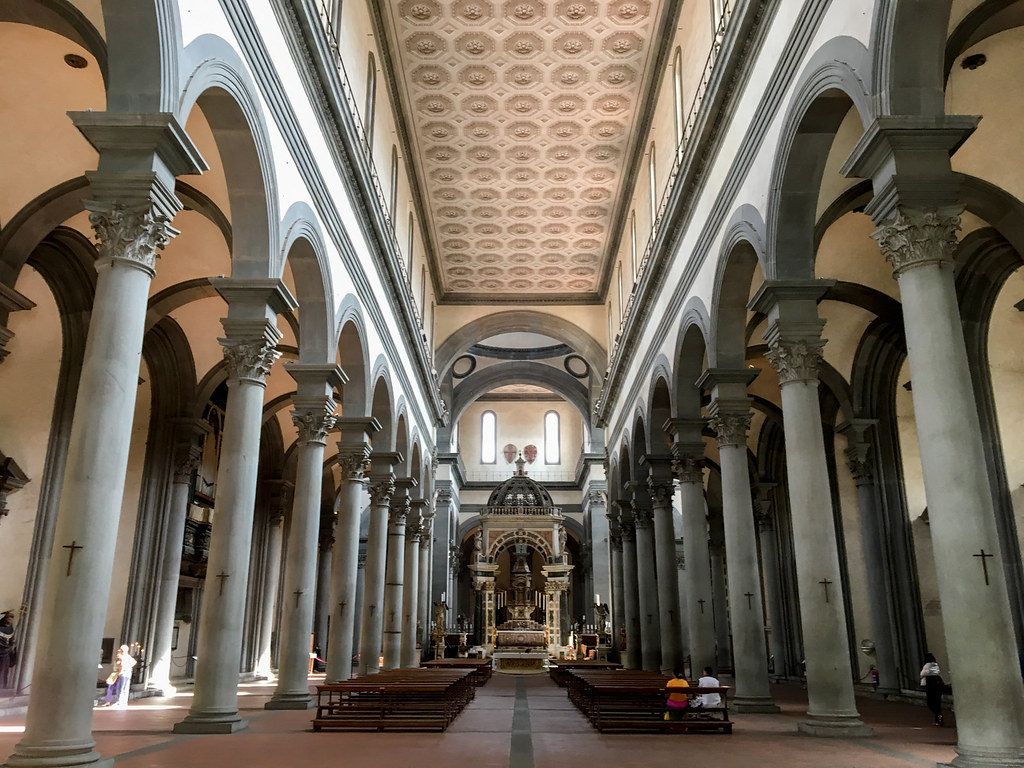
The Basilica di Santo Spirito is one of many incredible churches located in the Oltrarno neighborhood of Florence. Although the exterior is rather plain with a whitewashed facade, the interior is a remarkable work of Renaissance Architecture. The church is another impressive building designed by Filippo Brunelleschi. Work began on the building in 1446. Brunelleschi’s church was going to essentially rebuild an older church that had existed since the 12th century. Unfortunately, he died shortly after the start of construction, but the new builders maintained his original design.
13. Palazzo Medici

Palazzo Medici is a very famous Renaissance palace that was built by the Medici Family. The palace was built during the mid-15th century, at a time when the Medici were reaching their peak as Florence’s leading family. The palace features some of the most iconic elements of Renaissance Architecture. The main interior courtyard contains many sculptures, including marble statues displayed in purpose-built niches along the walls. This was a common feature in Ancient Roman Architecture, as were the Corinthian Capitals that can be seen at the tops of the columns. One of the defining characteristics of Renaissance Architecture is the use of elements from Ancient Greek and Roman buildings.
14. San Marco Museum
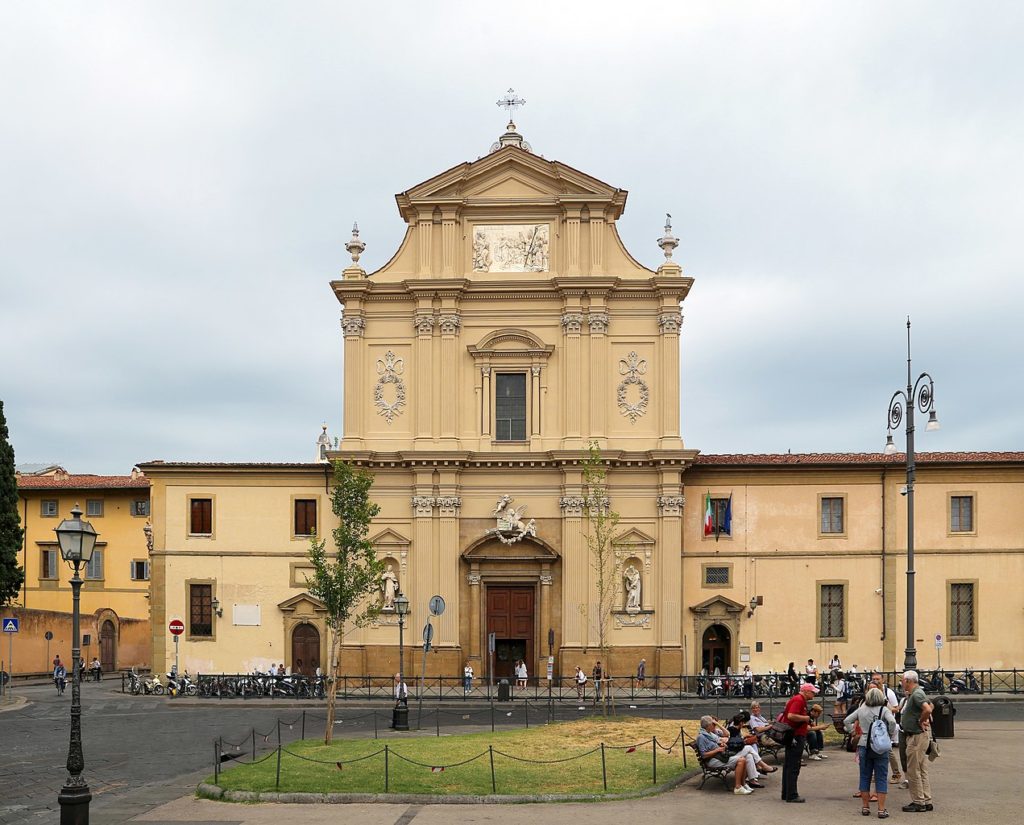
Originally, San Marco was a humble Dominican Friary containing a church and some monk’s quarters. But over time the Dominican Friars expanded and built a complex of buildings, which today houses the Museo Nazionale di San Marco. The San Marco Museum showcases a select few frescoes painted by Fra Angelico, one of the monks living at the Monastery. Fra Angelico was famous as an innovative early Renaissance painter, and if it wasn’t for the advances that he made during his career from 1395-1455, we wouldn’t have ever seen some of the masters of the late Renaissance.
15. Loggia del Mercato Nuovo

Loggia del Mercato Nuovo is a Renaissance-style Loggia that covers up a small market in modern-day Florence. The original structure dates from the mid-16th century. The proportions of the loggia are elegant and show how architects at the time were focusing on making their buildings balanced and harmonious. The short facade and the long facade are very different from one another, but somehow, they still work together to make one unified building. The loggia’s only function is to shelter the marketplace below, and it shows how the people of Florence valued beautiful architecture, even if that architecture was only built for functional reasons.
Baroque Architecture and the Grand Duchy of Tuscany

Map of Florence highlighting the most notable works of Baroque Architecture within the city. All of the 16th-century additions to the defensive walls are also outlined,
The wealth and power of the Medici helped push the city’s status to new heights. In 1569, the Medici were elevated to Grand Dukes, and Florence became the capital of the Grand Duchy of Tuscany. Although the spirit of the Renaissance was still alive and well in the city, Baroque Architecture would be the main influential style in Florence by the 17th century. Florence was at a cultural high point during the final centuries of Medici Rule, which would finally end in 1737. After that, Florence would be briefly under the influence of the Austrian Habsburg Empire, and the Holy Roman Empire. The Grand Duchy of Tuscany would last from 1569 until 1859, when it joined the newly united nation of Italy.
1. Cappella dei Principi (Medici Chapel)

Like a lot of famous dynastic families, the Medici went to great lengths constructing tombs and mausoleums for themselves. In the Renaissance Age, they commissioned Michelangelo to design the New Sacristy at the Basilica di San Lorenzo. In the early 17th Century, the Medici commissioned the Cappella dei Principi, often referred to as the Medici Chapel. This octagonal space is topped with a massive dome that is 193 feet (59 m) tall, and although much smaller, it was built using similar techniques as Brunelleschi’s dome as Florence Cathedral.
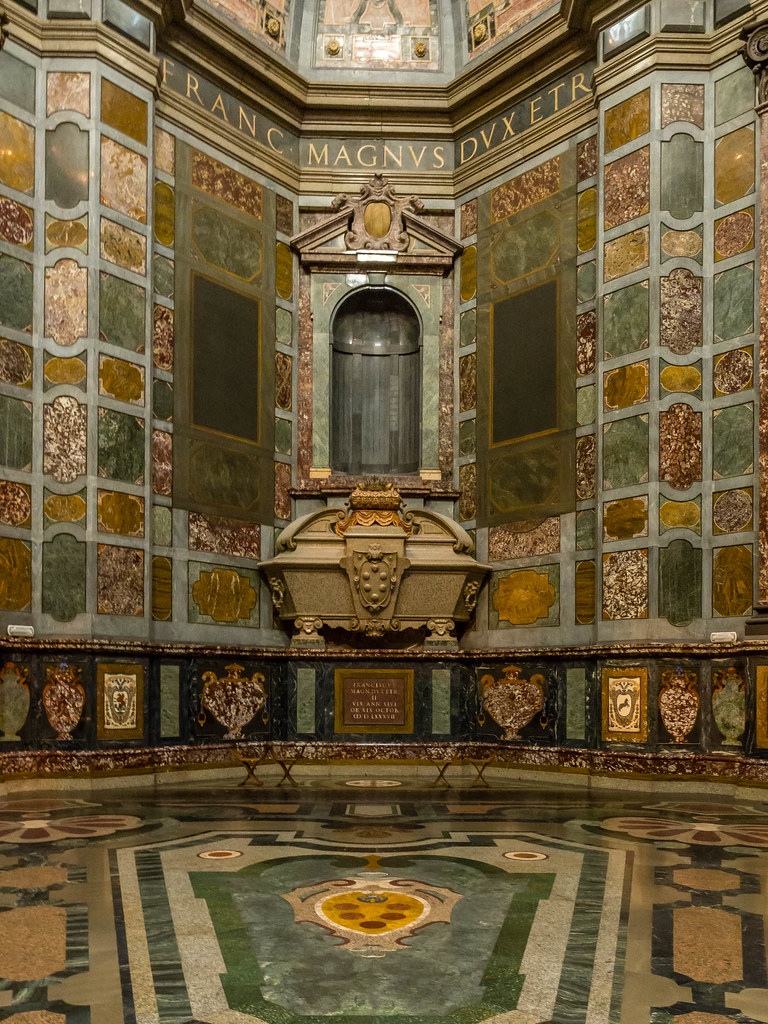
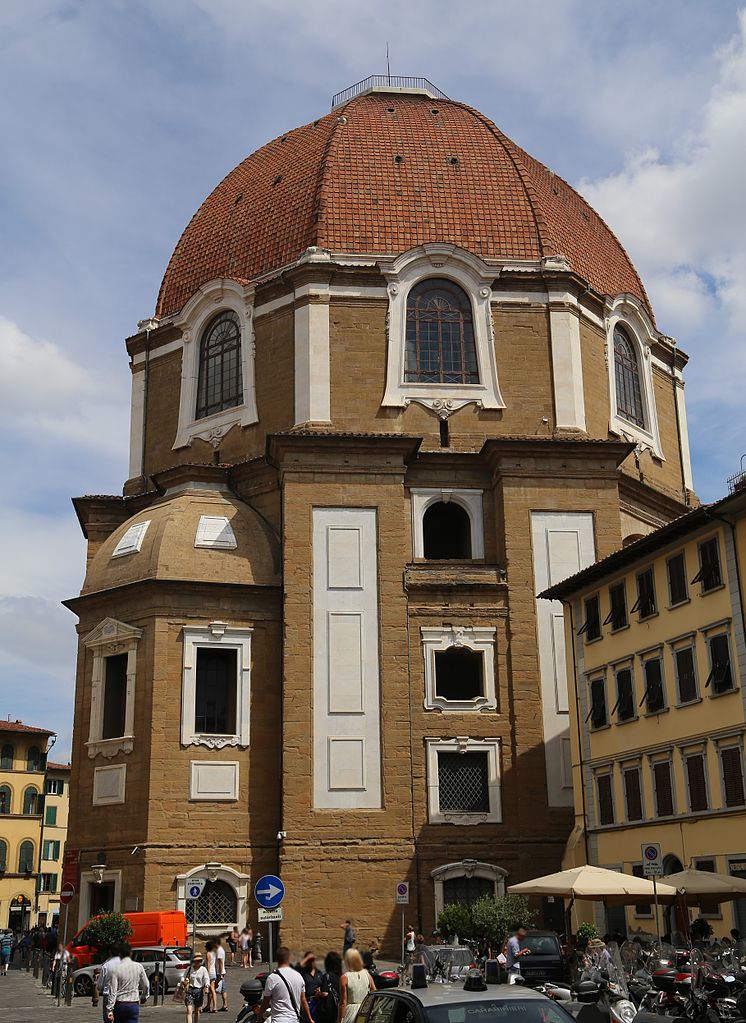
(right) Photo by Rufus46 from Wikimedia Commons
The Cappella dei Principi was built after the Renaissance, at a time when Baroque art and architecture were sweeping across Europe. In the Baroque age, architecture got a lot more flashy and a lot more lively. You can see that within the dome of the Medici Chapel, where the frescoed ceiling is covered with Baroque-style paintings. The walls still feature a lot of Italian Marble like many other Renaissance and even Romanesque buildings on this list, but this time in the Baroque age, everything is turned up a bit. All of the different stones contrast in shape and color, and all of the movement in the various marbles makes the walls seem that much more complex.
2. Boboli Gardens

The Palazzo Pitti remained the official residence of the Medici Rulers of Florence through the 17th century. The Medici constructed an 11-acre complex of gardens, sculptures, and fountains behind the Palazzo Pitti, known as the Boboli Gardens. These gardens are in a similar style to many Italian Gardens from the Baroque Age. Several different grottos were built within the Boboli Gardens, including the Grotto of Adam and Eve.
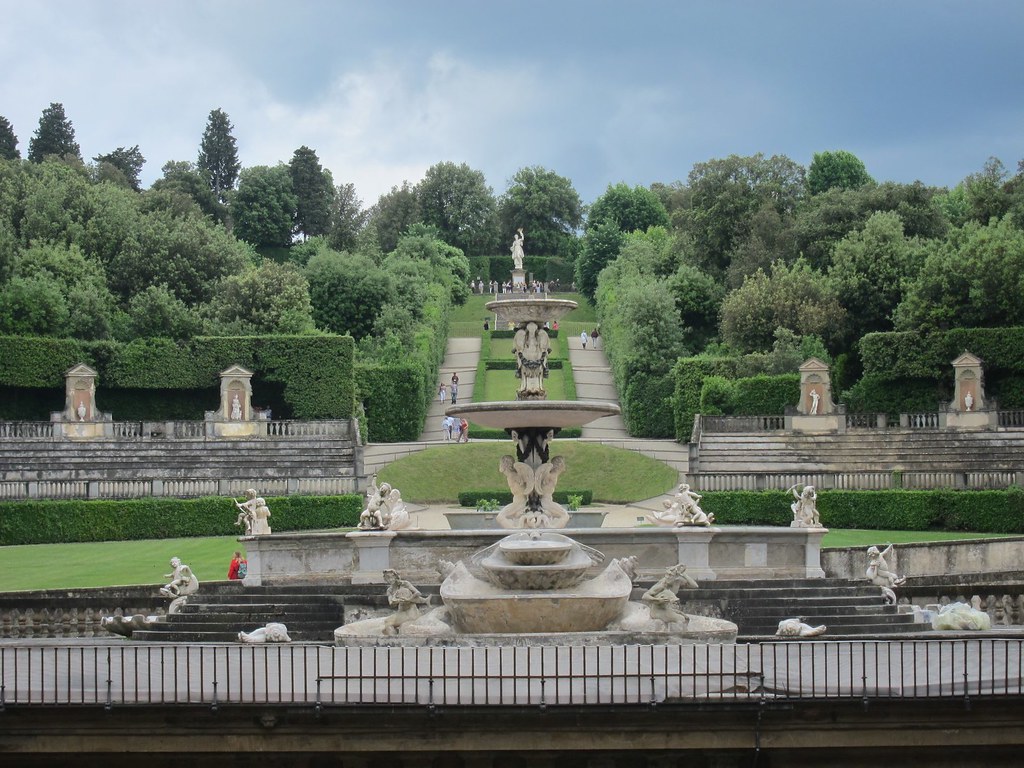
The Boboli Gardens Amphitheater contains dozens of marble sculptures, all orientated around a central fountain. Its called the “Amphitheater” because the statues are arranged around a large oval-shaped walkway, in the same shape as an Ancient Roman Amphitheater. The sculptures themselves are also in the same style as many marble statues from classical Greece and Rome. Borrowing elements from the architecture of antiquity is an important characteristic of Baroque and Renaissance Architecture.
3. Fortezza da Basso & Fort di Belvedere

Although Florence already had a Medieval Wall that was centuries old, the city decided to improve its fortifications in the 16th & 17th centuries. Fortezza da Basso and Fort di Belvedere are two large star forts located on the outer edges of Florence’s historic center. Both forts were built after the age of gunpowder, which forever changed defensive architecture. Unlike older Medieval Castles, these fortresses were built with short walls that were thick and packed with earth to absorb cannon fire. The Fort di Belvedere (depicted above) is located on a hill overlooking the entire city, and many people climb the walls to get excellent views of Florence below.
4. Ognissanti
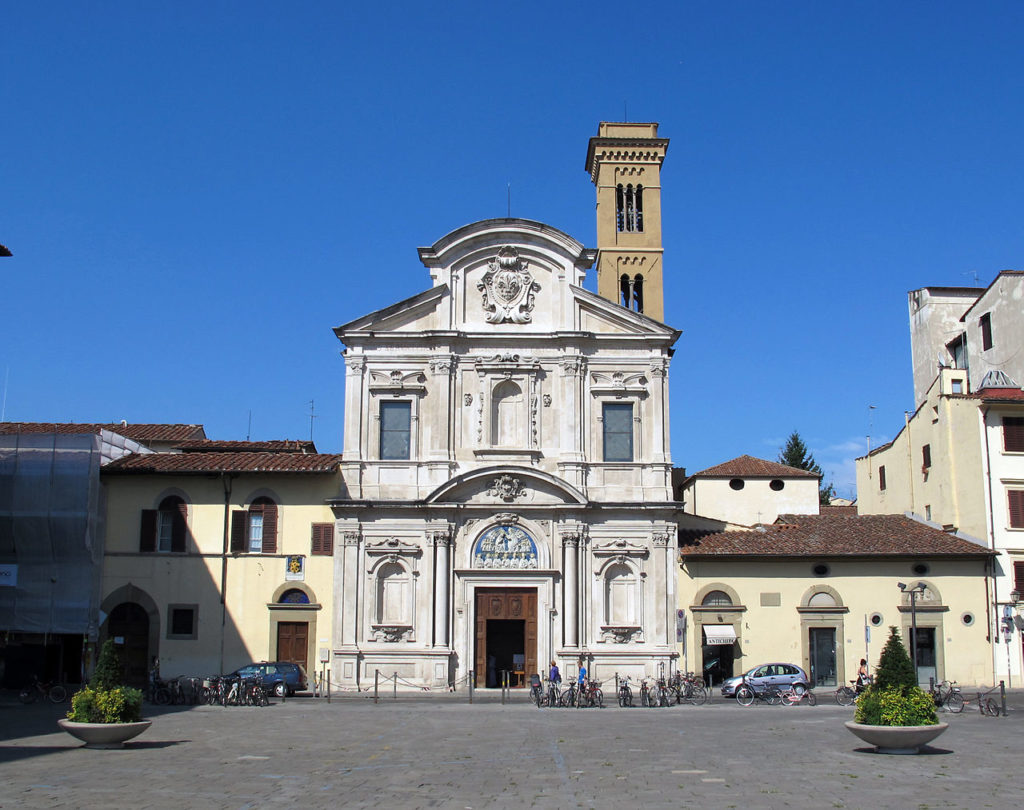
The Chiesa di San Salvatore di Ognissanti is a Baroque Church located in Piazza Ognissanti, a square located right next to the banks of the Arno River. The church originally dates to the 13th century, but most of the exterior facade and interior decorations date from 1627-1637 in the early part of the Baroque Age. The facade features a lot of the key elements of Baroque Architecture like the elliptical geometries and the intricate stone carvings. But these characteristics are definitely scaled back when compared to later Baroque Facades.
5. Complex of San Firenze

Located a few steps to the east of Piazza della Signoria, the Complex of San Firenze is a collection of Baroque buildings dating from the 17th century. There is a church, museum, and the remnants of a palace, once owned by a wealthy Florentine Noble. The auditorium (depicted above) is one of the grandest spaces within the complex. Although Rome is often considered the most important Baroque City within Italy, buildings like the ones at the Complex of San Firenze show how Florence contains many great works of Baroque Architecture.
19th Century Architecture in Florence
Florence grew into a larger and more modern city in the 1800s. The Industrial Revolution had a significant effect on Italy, and several new railroads were built throughout Tuscany. Florence then became better connected with nearby cities like Rome, Bologna, and Pisa, which lead to improved economic growth. But the 19th Century was also a turbulent time for both Florence and the rest of Italy. Napoleon absorbed the Grand Duchy of Tuscany into the French Empire for a brief period from 1807-1815. It wasn’t until 1859 that Florence joined the Italian Unification Movement; which led to the establishment of the Kingdom of Italy two years later. Even though architecture at this time had evolved significantly, many new buildings from this era still borrow elements from older buildings in Florence.

Map of Florence highlighting important works of architecture from the 19th Century. During the 1800s city officials demolished large portions of the defensive walls – the removed portions are shown with a dashed line.
1. Piazzale Michelangelo
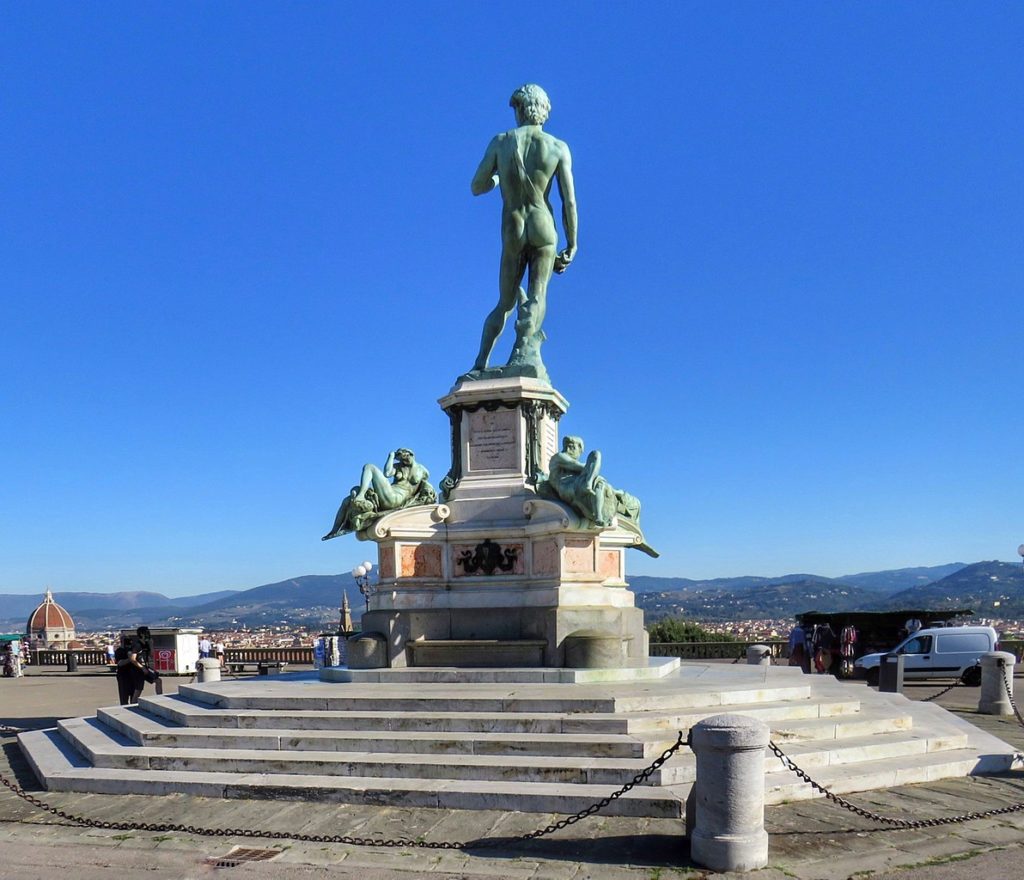
The Piazzale Michelangelo is arguably the best spot to view the historic center of Florence from above. Every evening, the square is packed with people who want to watch the sunset over the city’s skyline. The square was built in 1869, during the 6 year period when Florence was the capital of the Kingdom of Italy. The most notable feature of Piazzale Michelangelo is the statue dedicated to the works of Michelangelo. A bronze-cast replica of his David statue stands atop a stone pedestal. At the corners of the pedestal are four copies of Michelangelo’s four sculptures from the New Sacristy of San Lorenzo. Each one is a figure representing night, day, dawn, and dusk.
2. Piazza Della Repubblica

Piazza Della Repubblica is one of Florence’s largest squares, and it sits on the site of the city’s original Roman Forum. The square was filled with lots of other buildings in the early 1800s. But later on, city officials made the controversial decision to demolish the historic neighborhood to create the opening for the square. Most of the demolition and the construction of the surrounding facades occurred from 1865-1895. A massive Triumphal Arch was built on the western side of the piazza, which has a design borrowing many distinct elements from Neoclassical Architecture.
3. The Great Synagogue of Florence
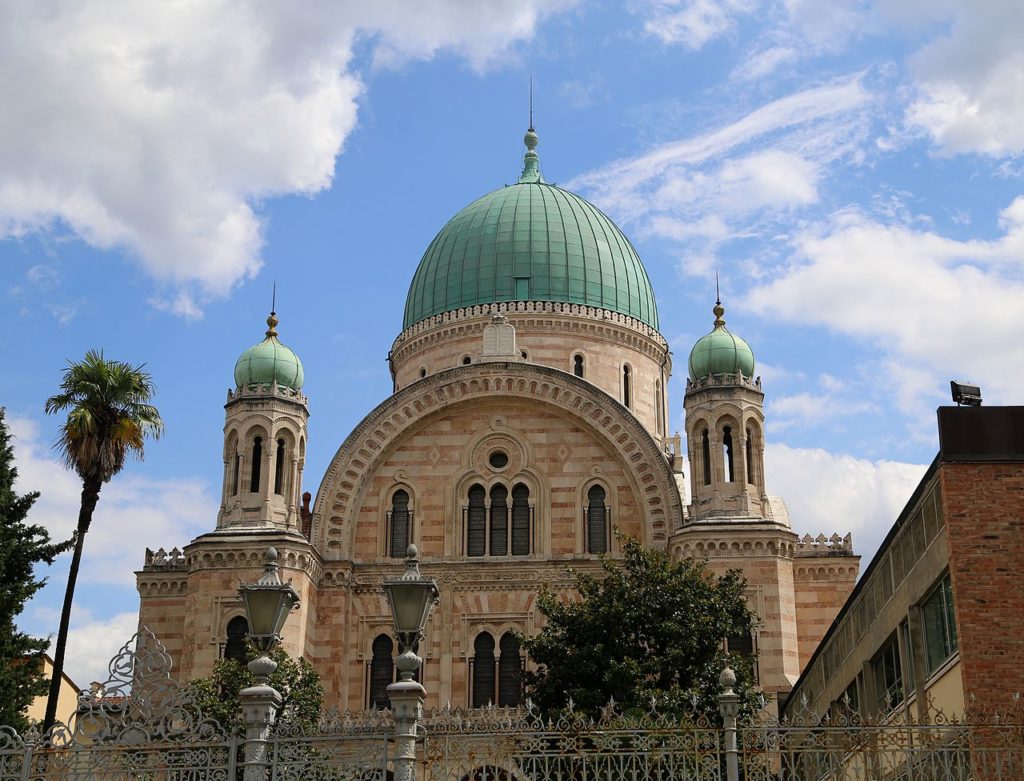
Florence contains a large Jewish community that goes back centuries, and this community has left a lasting impact on the city’s culture and architecture. In the late 19th century, private citizens funded the construction of a cluster of buildings that today includes a synagogue, classrooms, and a museum. Construction on the main temple began in 1874 and was completed by 1882, and today it’s known as the Great Synagogue of Florence. Like a lot of synagogues built in this time period, it is a Revivalist Structure that combines elements from Moorish and Islamic Architecture.
4. Mercato Centrale
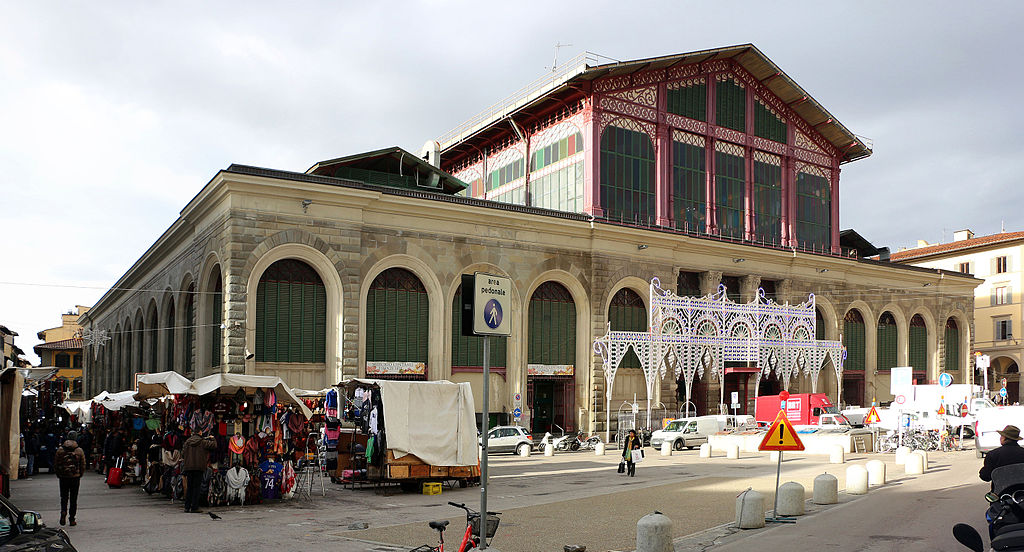
Mercato Centrale was designed by Giuseppe Mengoni, a prominent architect in Italy in the late 19th century. Mengoni also designed the Galleria Vittorio Emanuele II, which is one of the most famous sites in the city of Milan. The market is built using a combination of a masonry base topped with a roof made from a wrought iron skeletal structure. Today the Marcato Centrale is one of the busiest covered markets in the city. Many locals and tourists visit the building to buy bread, produce, and cheese from different vendors.
19th-Century Facades in Florence
Although most of the churches in Florence date from the Gothic and Renaissance ages, some of the front facades were built centuries later in the 1800s. Traditionally churches were built with rough stone exteriors as a way to save on costs, and then marble was added to the walls later on. Most of the facades from Florence’s cathedrals originally looked like the one from the Basilica di San Lorenzo. The Gothic Revival Facade of the Basilica di Santa Croce and Facade of Florence Cathedral both date to the 19th century.
1. Facade of Florence Cathedral

Just like many other Cathedrals throughout Europe, the construction of Florence Cathedral was a long, drawn-out process that lasted for hundreds of years. Some planned elements of the church were never even finished, such as the band of marble detailing located right below the dome. This historic photo shows the front of Florence Cathedral in the early 1800s before the marble facade was added. The new marble was picked from the same regions as the rest of the stone on the church to ensure the colors would match. Work on the facade was completed by 1887, and the giant bronze doors were installed in 1903.

2. Facade of Santa Croce
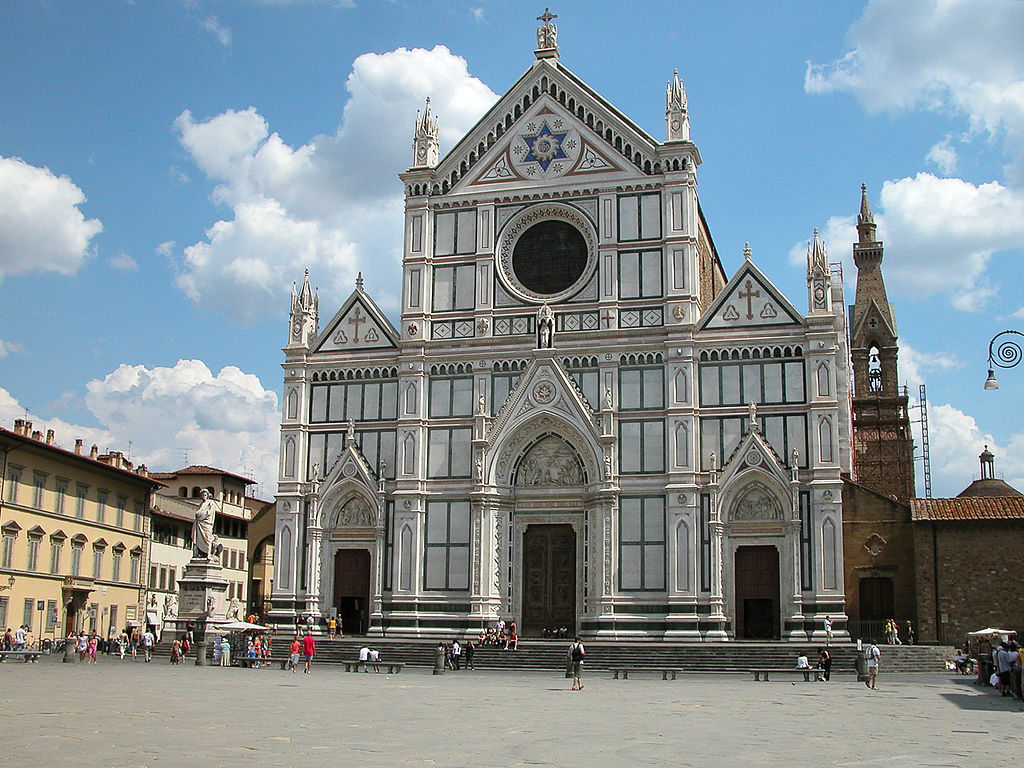
Santa Croce also featured a bare, rough-cut stone facade up until the 19th century. The church originally dates to the year 1294, and it was built primarily using Gothic Architecture. Eventually, at the same time as the Italian Unification Movement, there was a push to add a marble facade to the church. The Gothic Revival facade was completed in 1863, and it’s one of the best-preserved Italian Gothic facades in the entire country. The pointed arches and the pinnacles and spires throughout the design were all important characteristics from the Gothic Age.
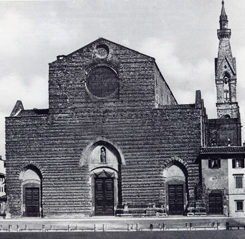

Photo by Sailko from Wikimedia Commons
Neighborhoods of Florence
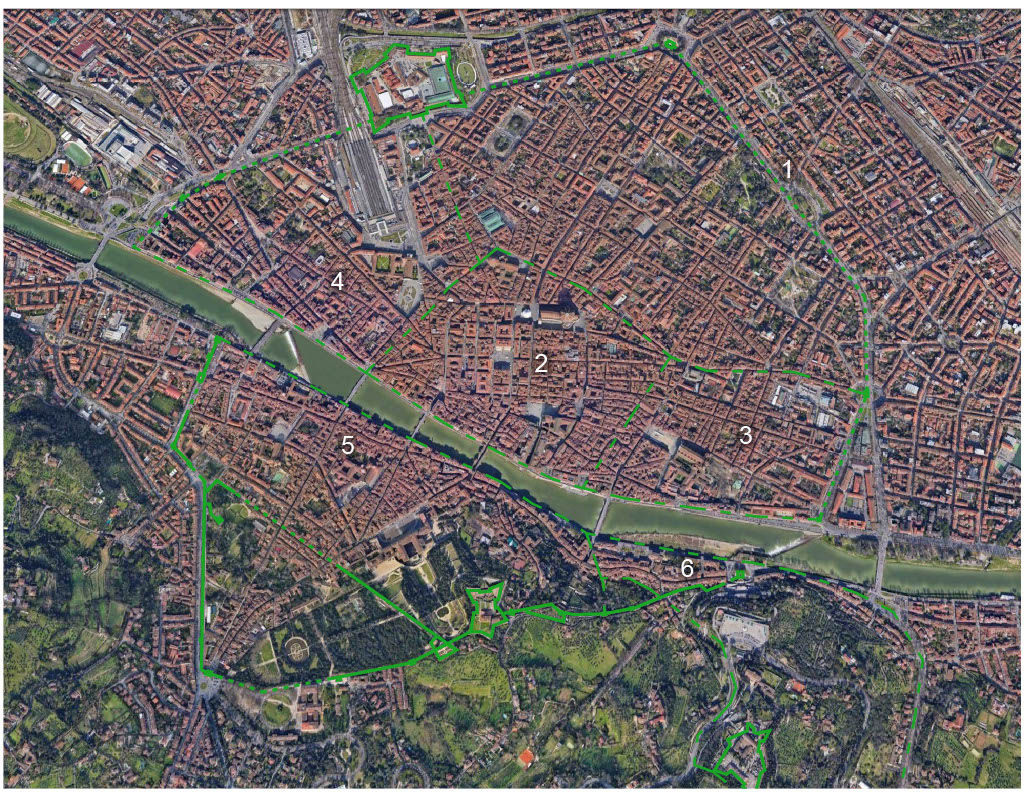
Map of Florence Showing the extents of the various neighborhoods within the city.

1. Historic Center
The entire historic center of Florence is part of a UNESCO World Heritage Site. The oldest part of Florence, this area was once bound by the city walls. Today nearly all of Florence’s main sites and attractions are located within this part of the city.

2. Duomo
A lot of the neighborhoods in Florence are simply named after the largest church in the area. The Duomo Neighborhood is by far the city’s most popular district for tourism. It contains Florence Cathedral, the Basilica di San Lorenzo, and the Palazzo Vecchio.

3. Santa Croce
Located east of the Duomo Neighborhood, Santa Croce is a district that surrounds the Basilica di Santa Croce. Although a little less commercial than the area around the Duomo, Santa Croce still contains a large number of shops, restaurants, and bars.

4. Santa Maria Novella
The largest train station in Florence is the Santa Maria Novella Railway station. This is why many people experience this neighborhood when they first arrive in Florence. The main attraction in this area is, of course, the church that gives the neighborhood its name, but you can also find Piazza Ognissanti nearby.

5. Oltrarno
Located across the Arno River from the oldest portion of Florence is the Oltrarno Neighborhood. The name essentially describes that the area is located across or beyond the Arno. Oltrarno is a large district that contains the Palazzo Pitti and the Basilica di Santo Spirito.

6. San Niccolò
Located on the southern bank of the Arno River next to the Oltrarno District, the Neighborhood of San Niccolò is one of the oldest parts of Florence. Here, you will find some of the best views in the city along with the sites of Piazzale Michelangelo and the Church of San Miniato al Monte.
Architecture of Florence: In Review
When it comes to historic architecture, Florence really is one of the most important cities in all of Europe. Not only was the city one of the greatest powers in medieval Italy, it was also the birthplace of the Italian Renaissance, and it remained an important cultural center long after that. The Renaissance masters like Alberti, Brunelleschi, Michelangelo, Raphael, and Donatello all left a lasting impact on the art and architecture of Florence. Most people visit Florence for its many Renaissance Age attractions, but they are often surprised at the city’s early medieval, Baroque, and modern works of architecture as well.

- About the Author
- Rob Carney, the founder and lead writer for Architecture of Cities has been studying the history of architecture for over 15 years.
- He is an avid traveler and photographer, and he is passionate about buildings and building history.
- Rob has a B.S. and a Master’s degree in Architecture and has worked as an architect and engineer in the Boston area for 10 years.
Like Architecture of Cities? Sign up for our mailing list to get updates on our latest articles and other information related to Architectural History.
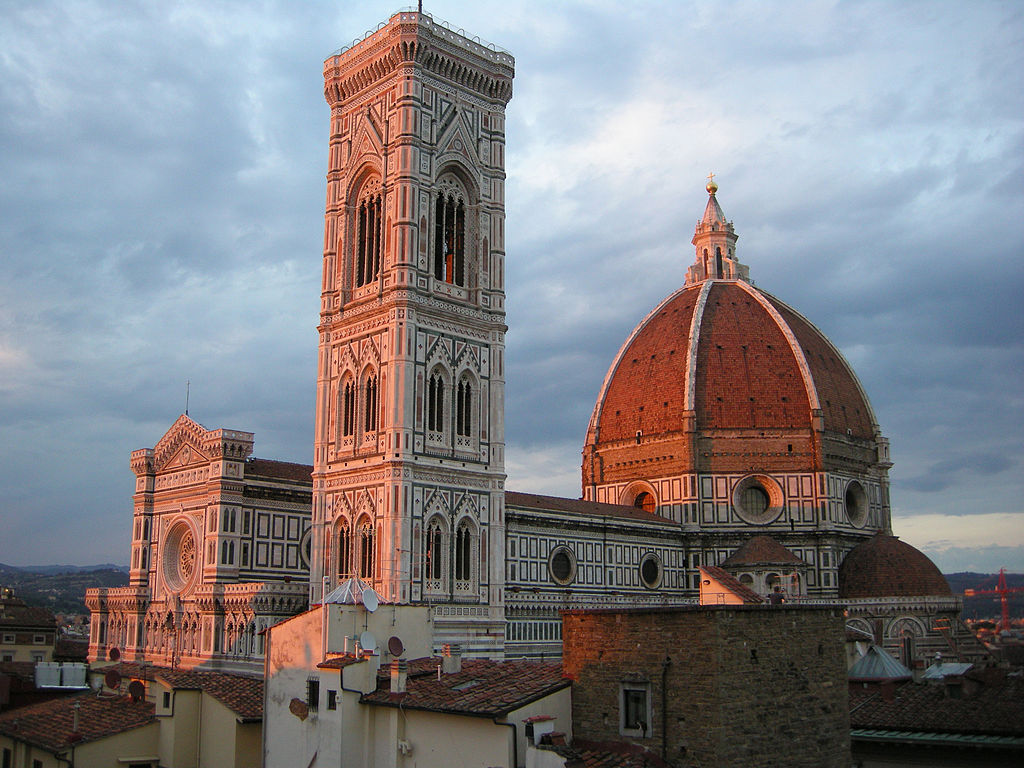
Photo by Sailko from Wikimedia Commons






